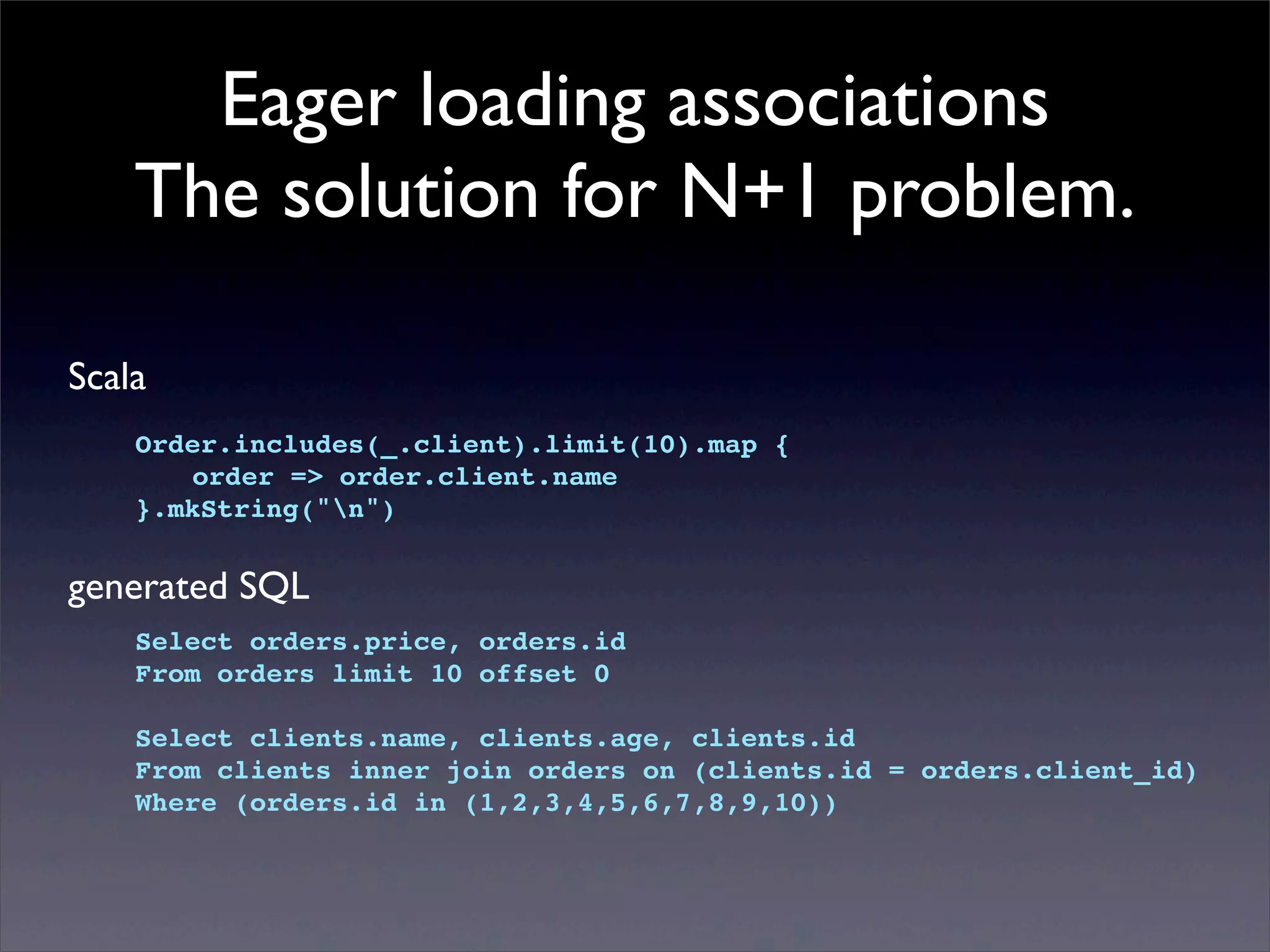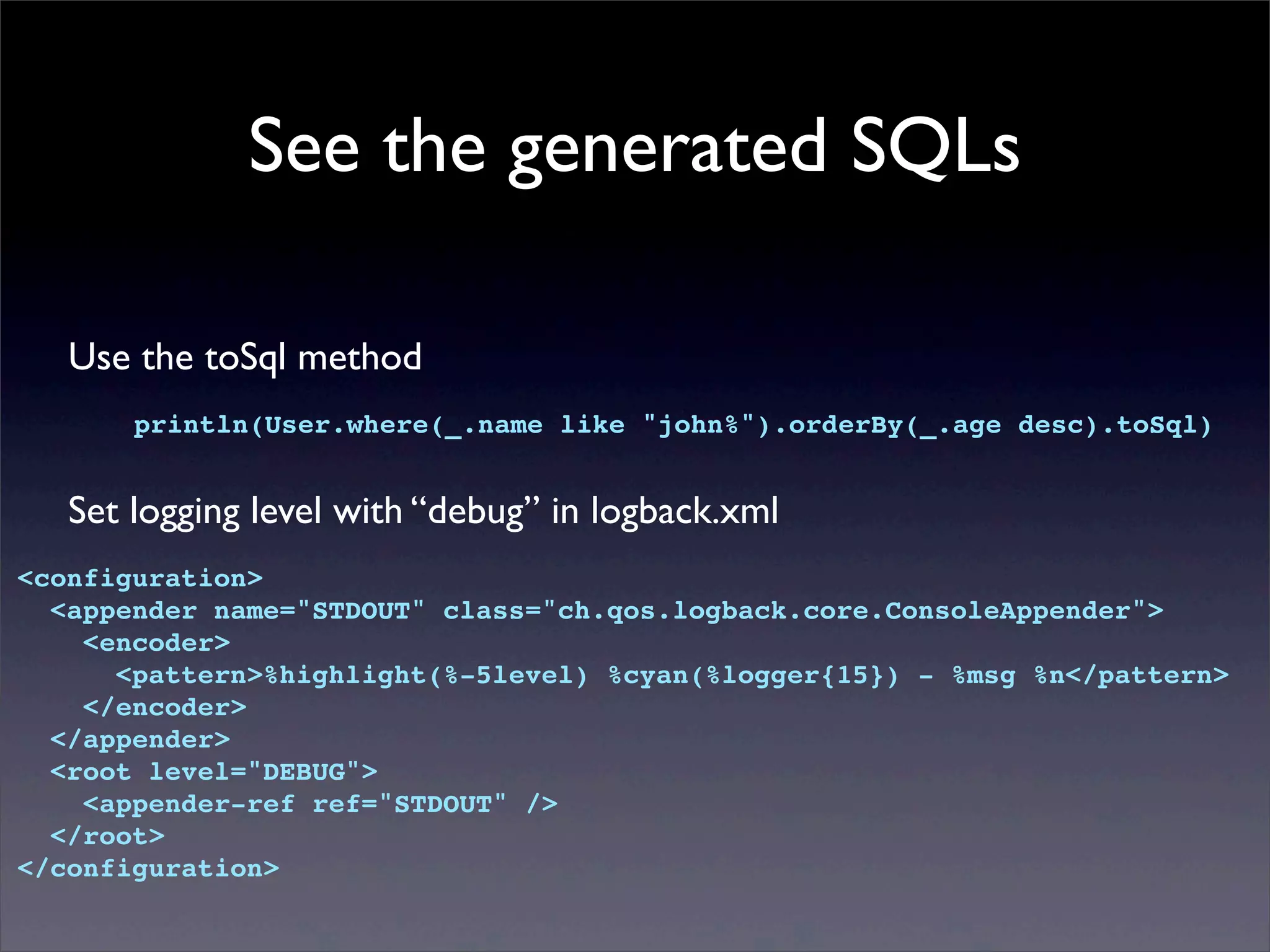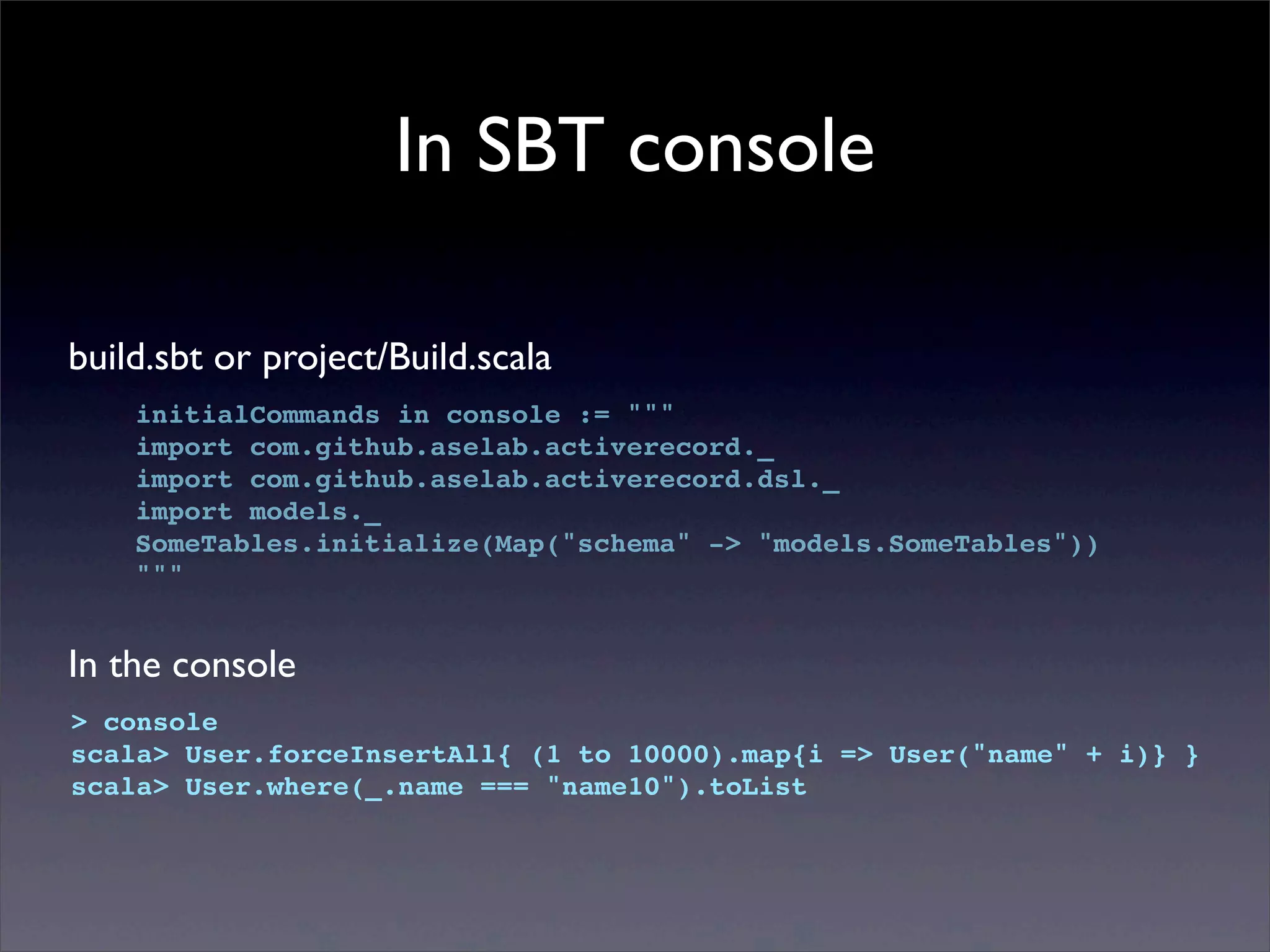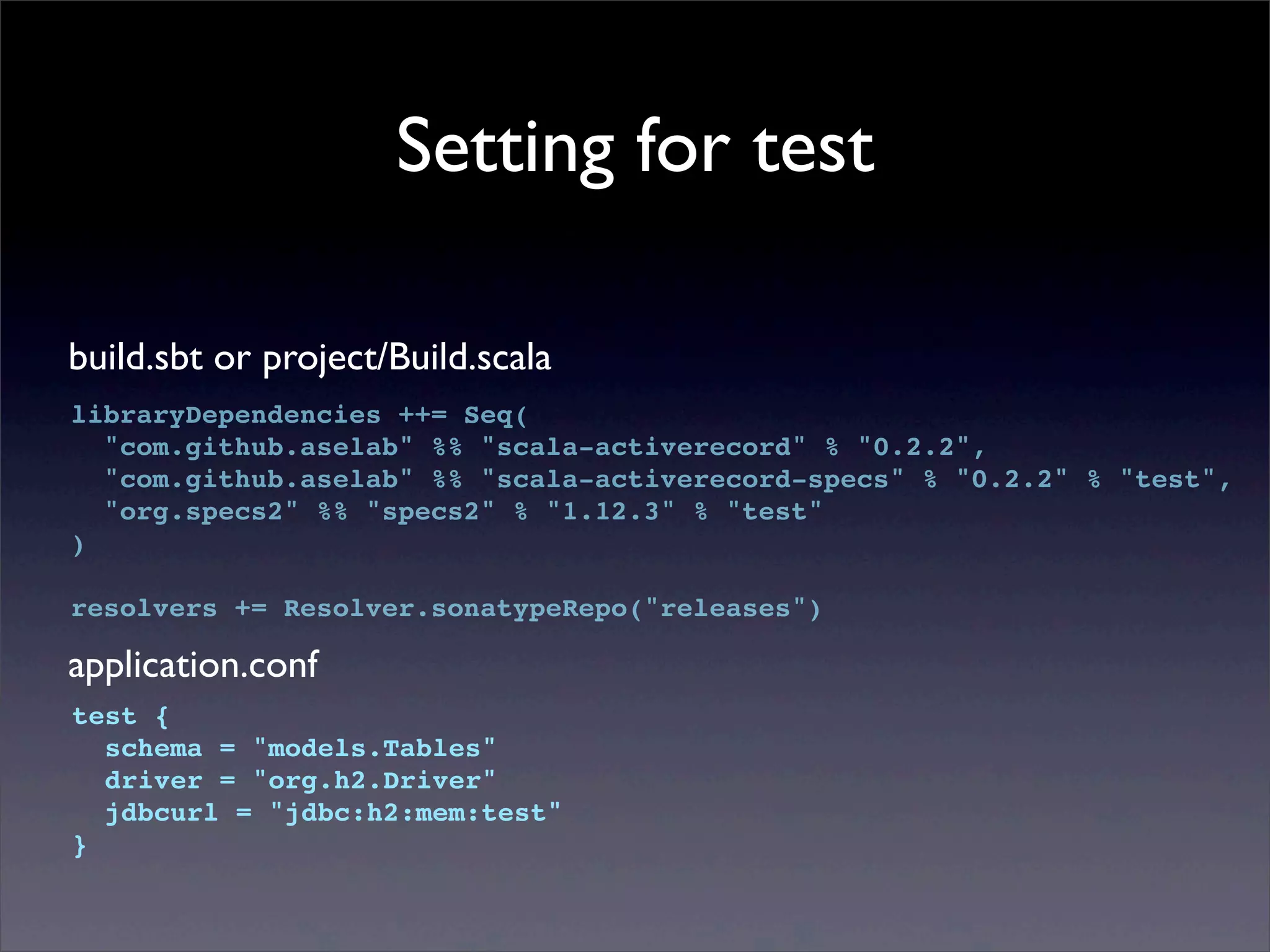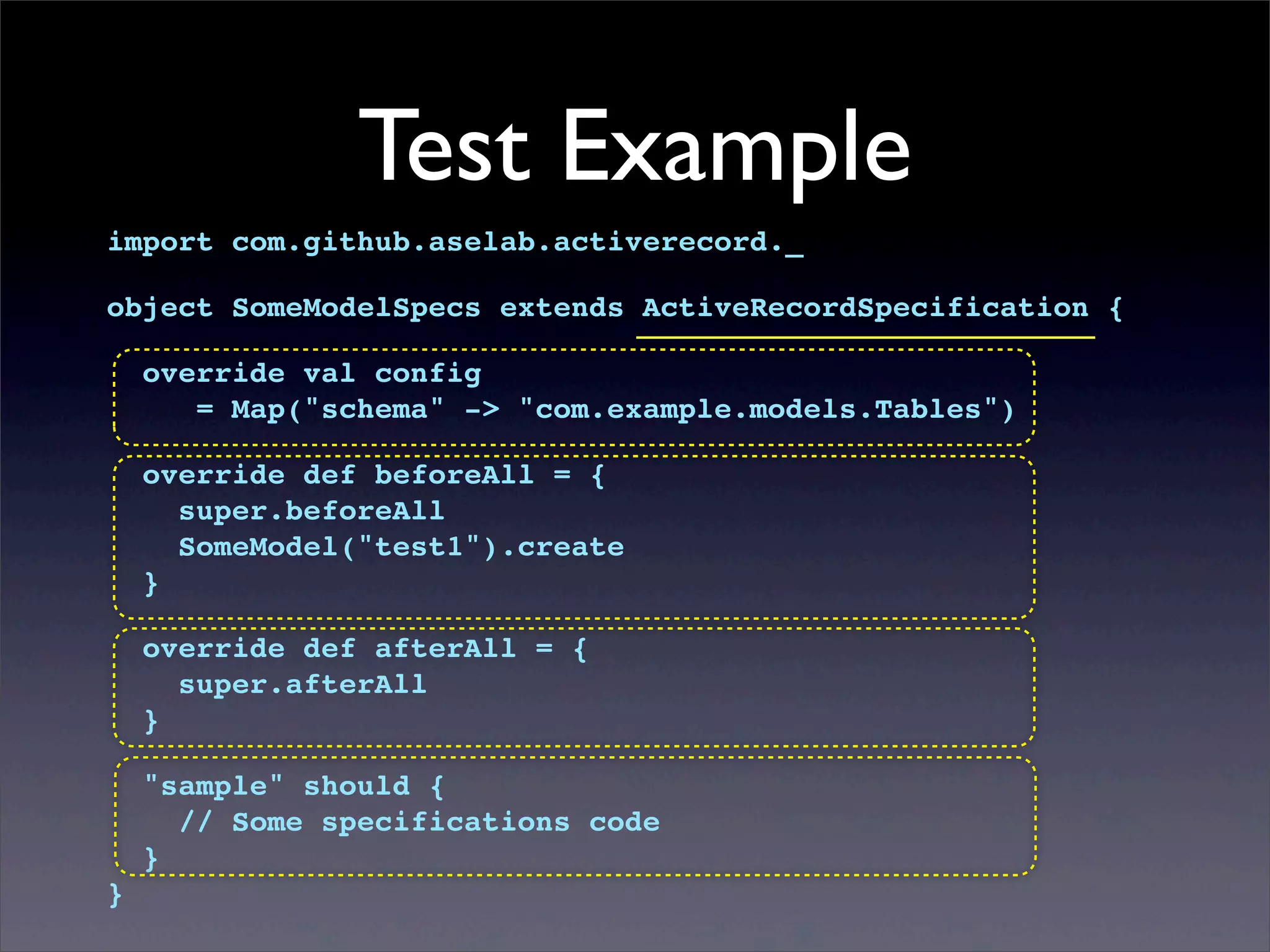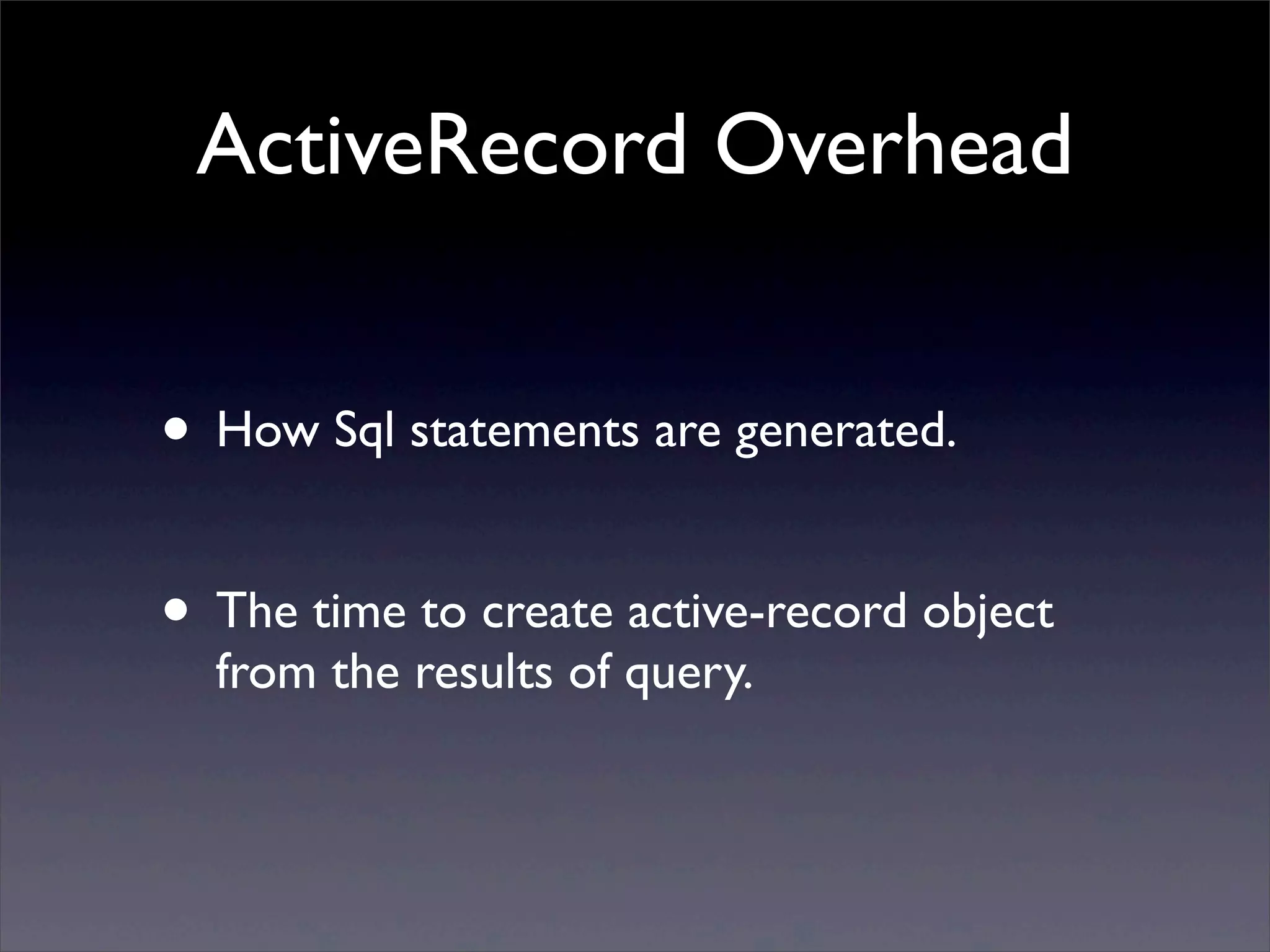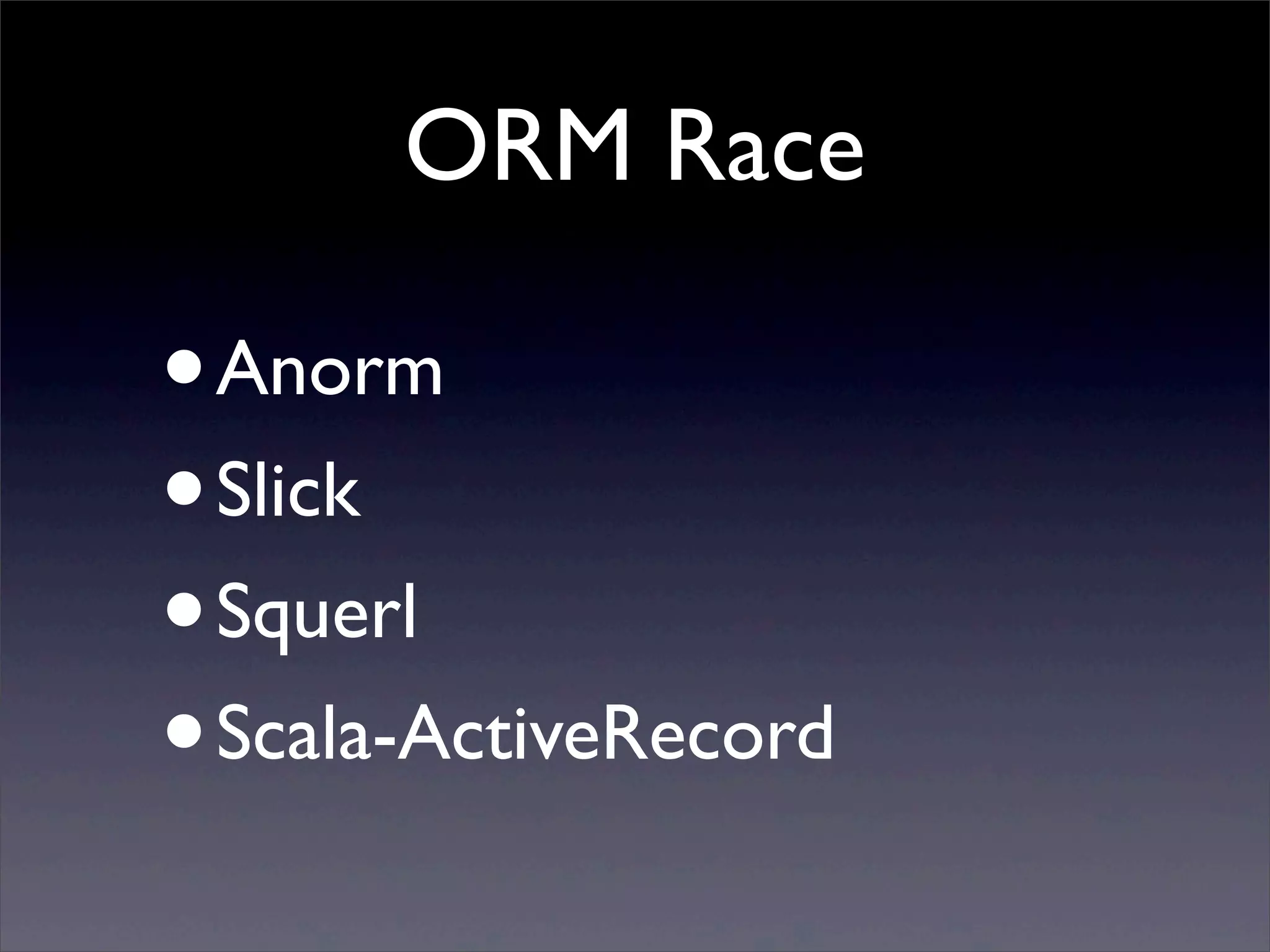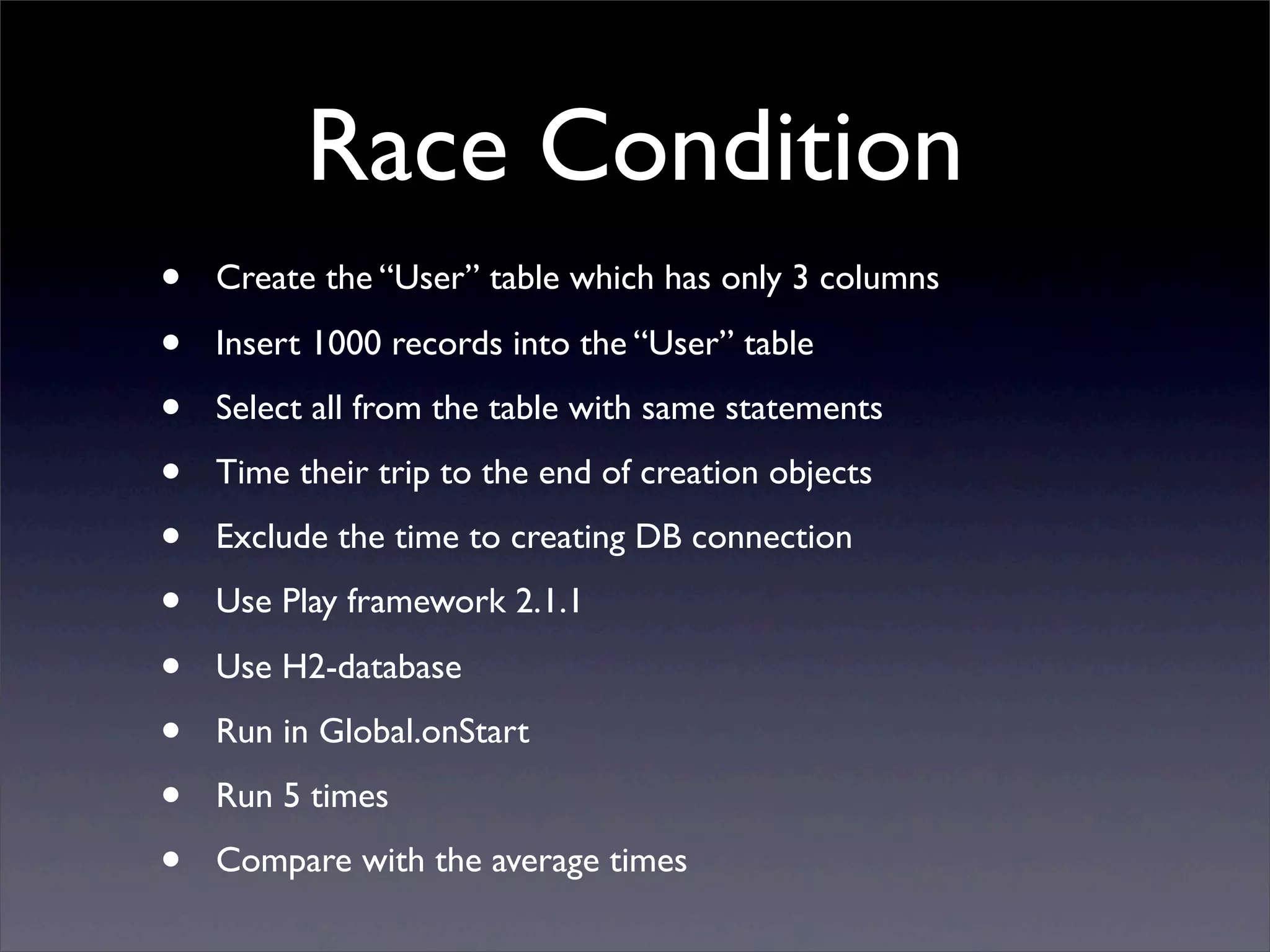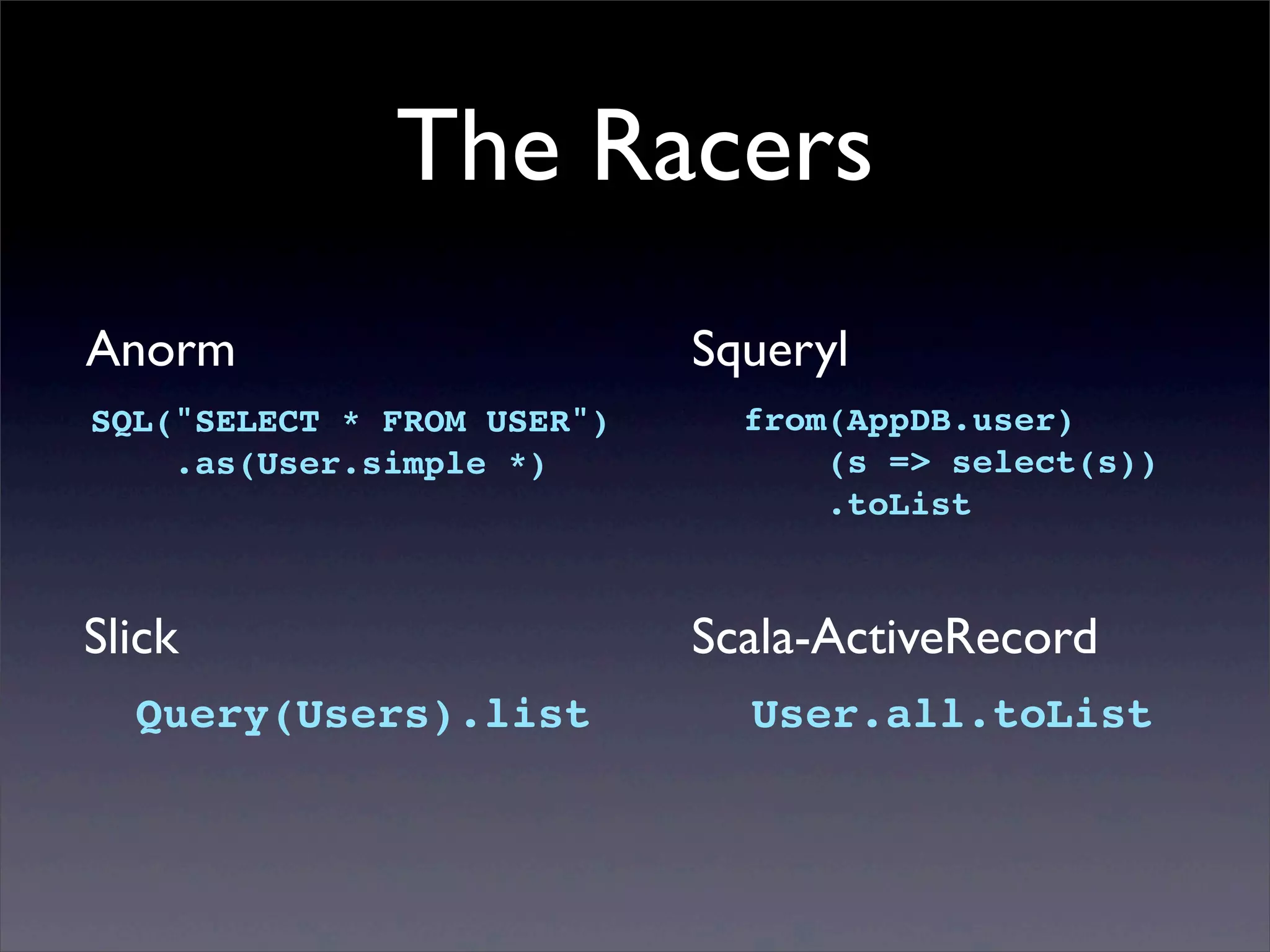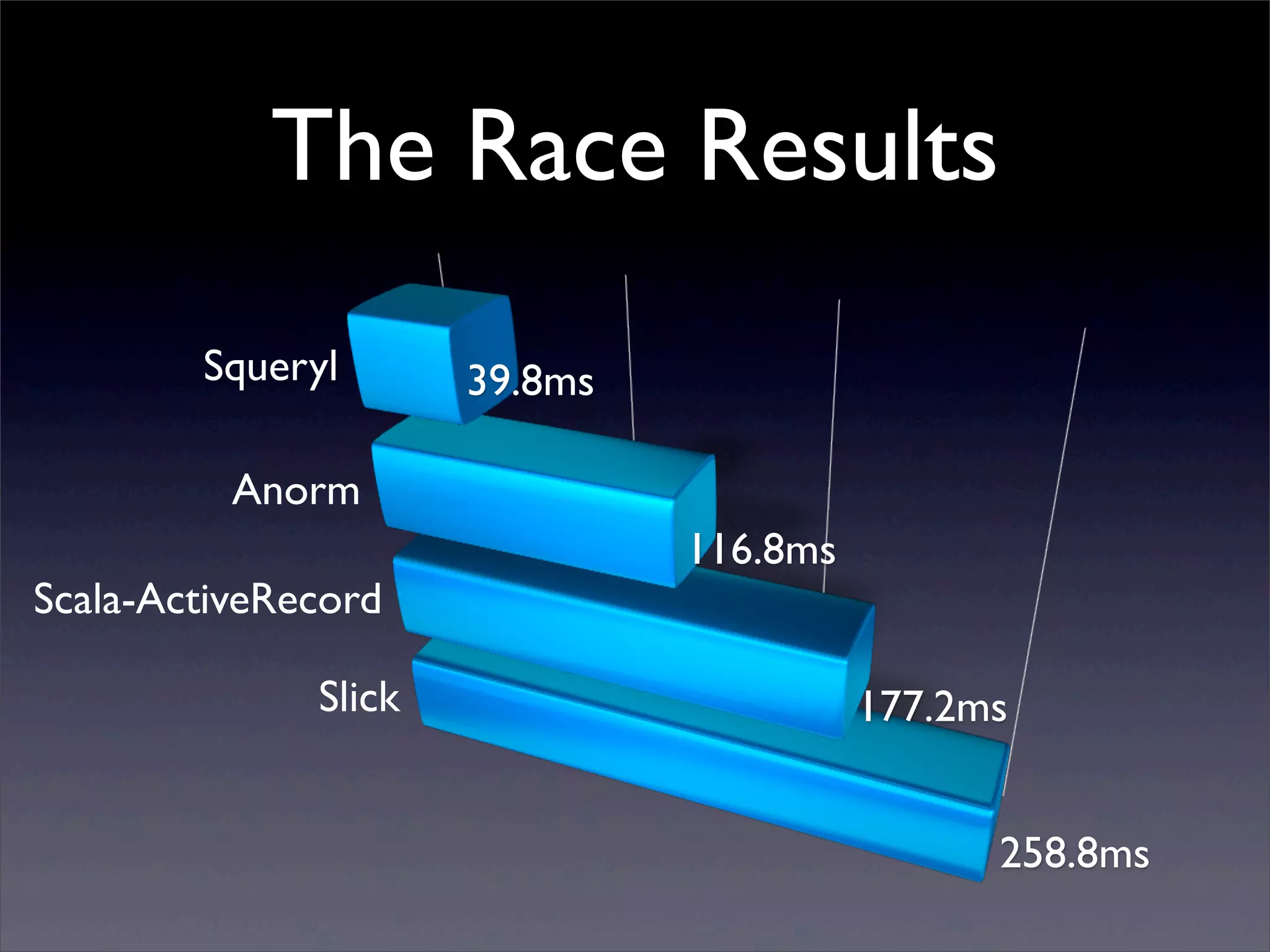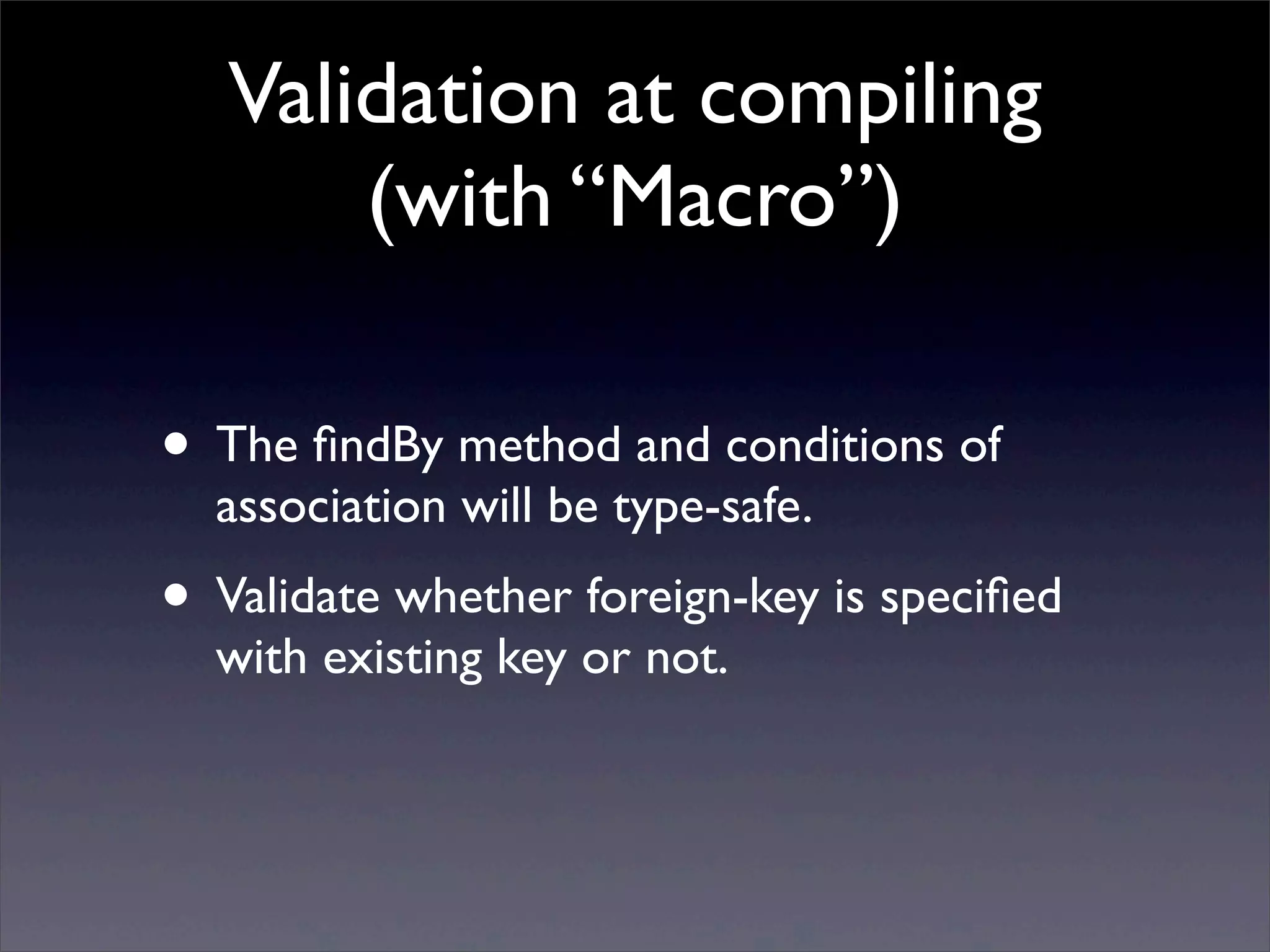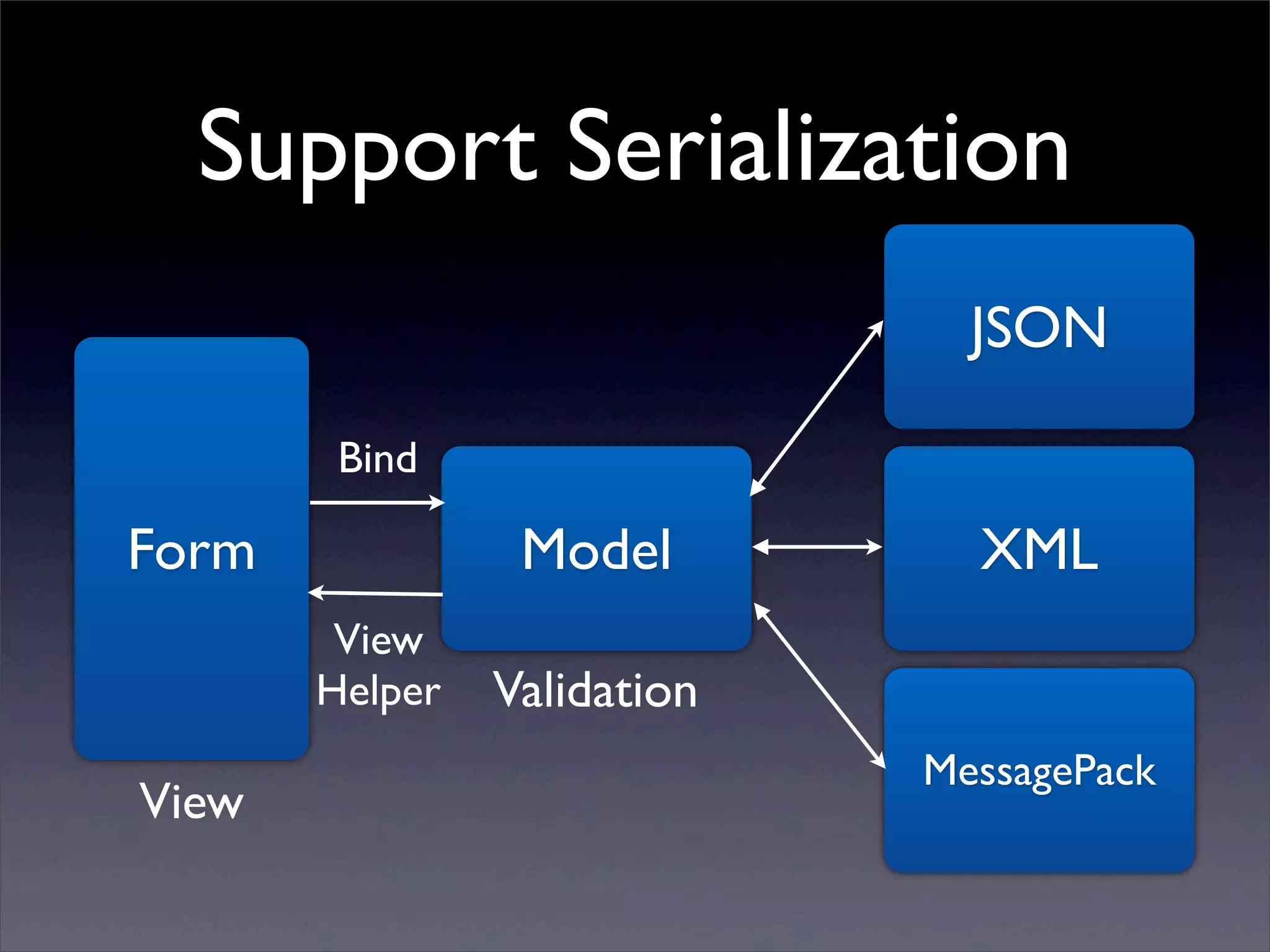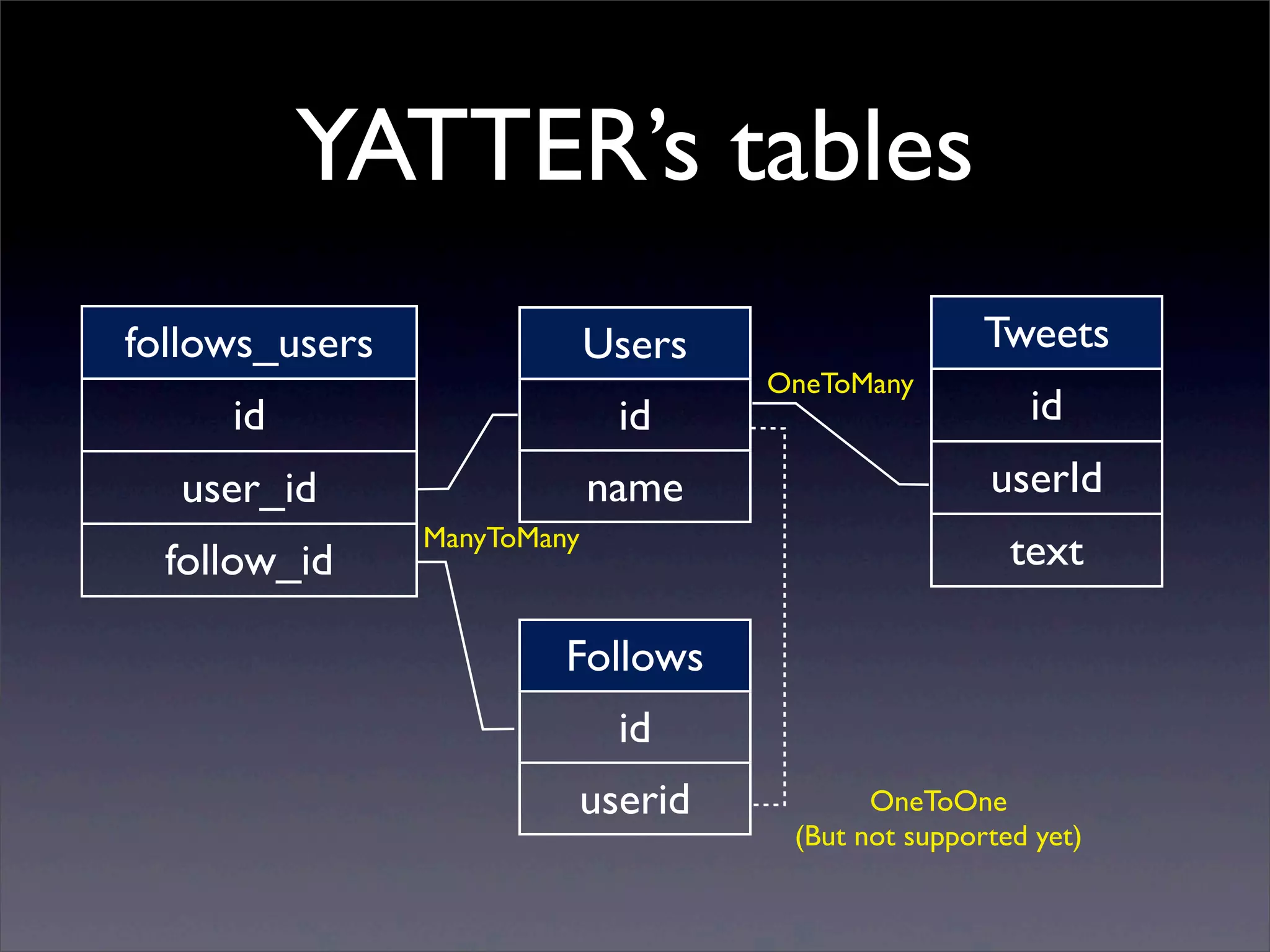This document provides an overview of Scala-ActiveRecord, a type-safe Active Record model library for Scala. It discusses features such as being type-safe, having Rails ActiveRecord-like functionality, automatic transaction control, and support for associations and validations. The document also covers getting started, defining schemas, CRUD operations, queries, caching queries, validations, callbacks, and relationships.
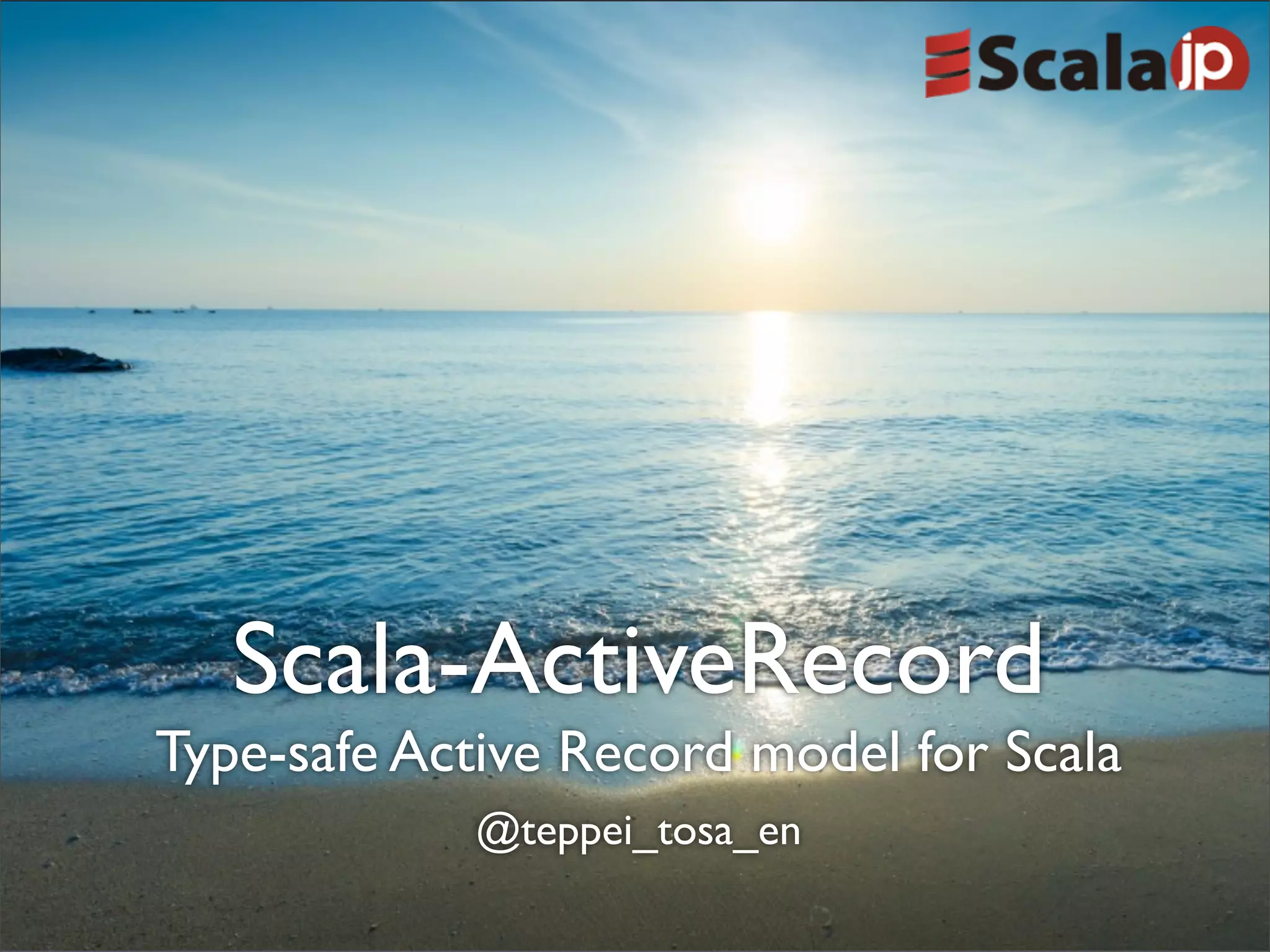
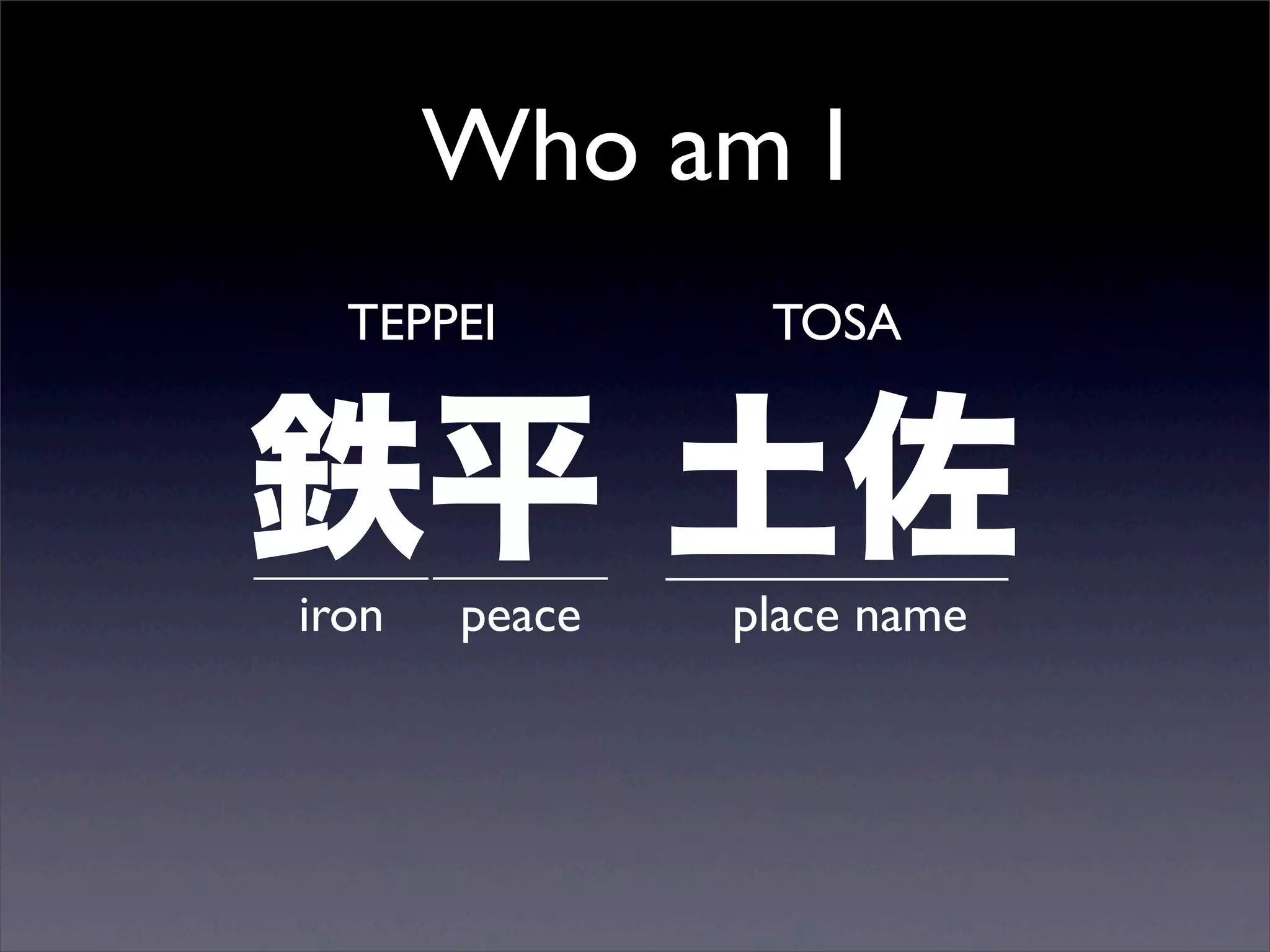


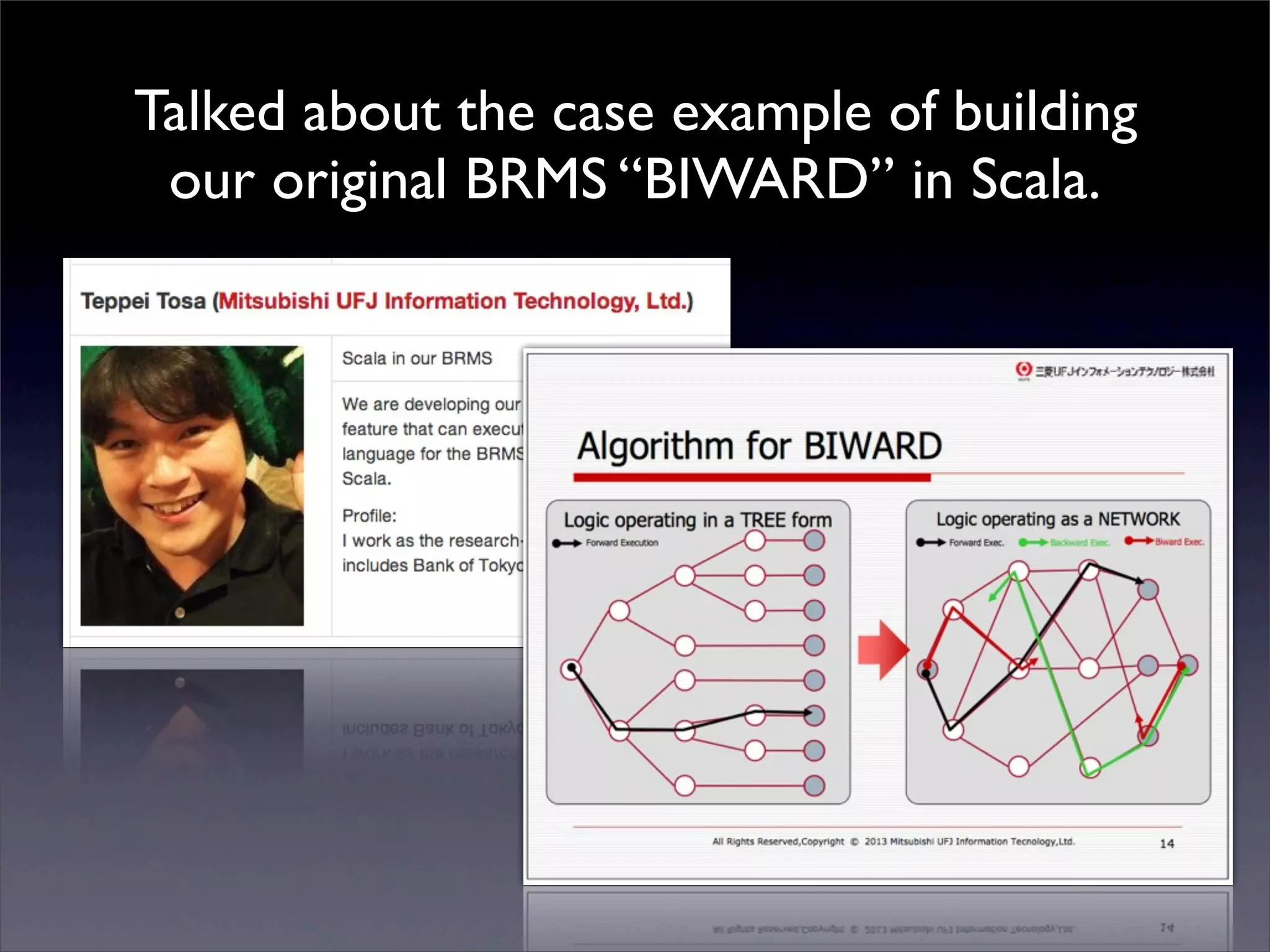

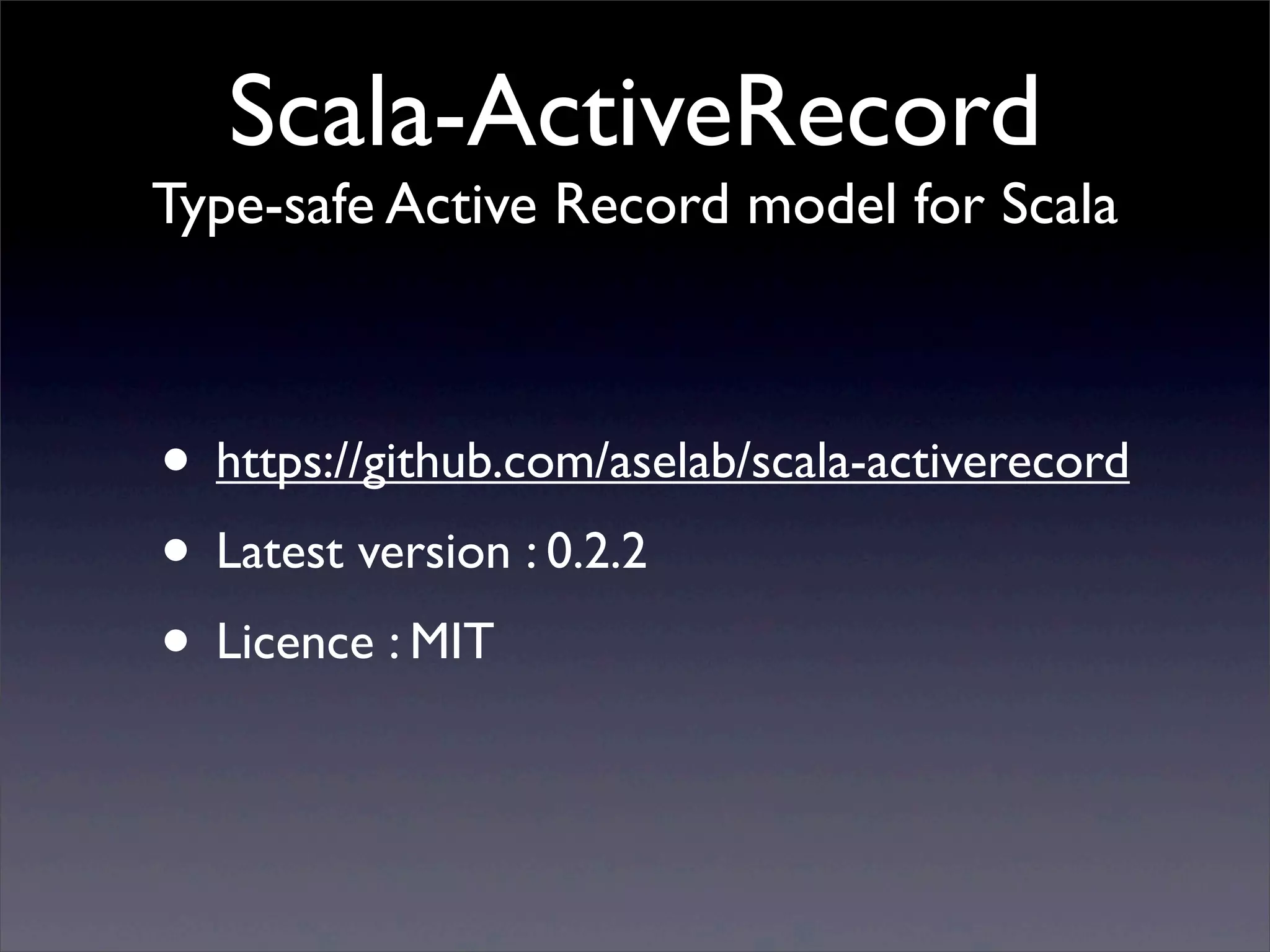
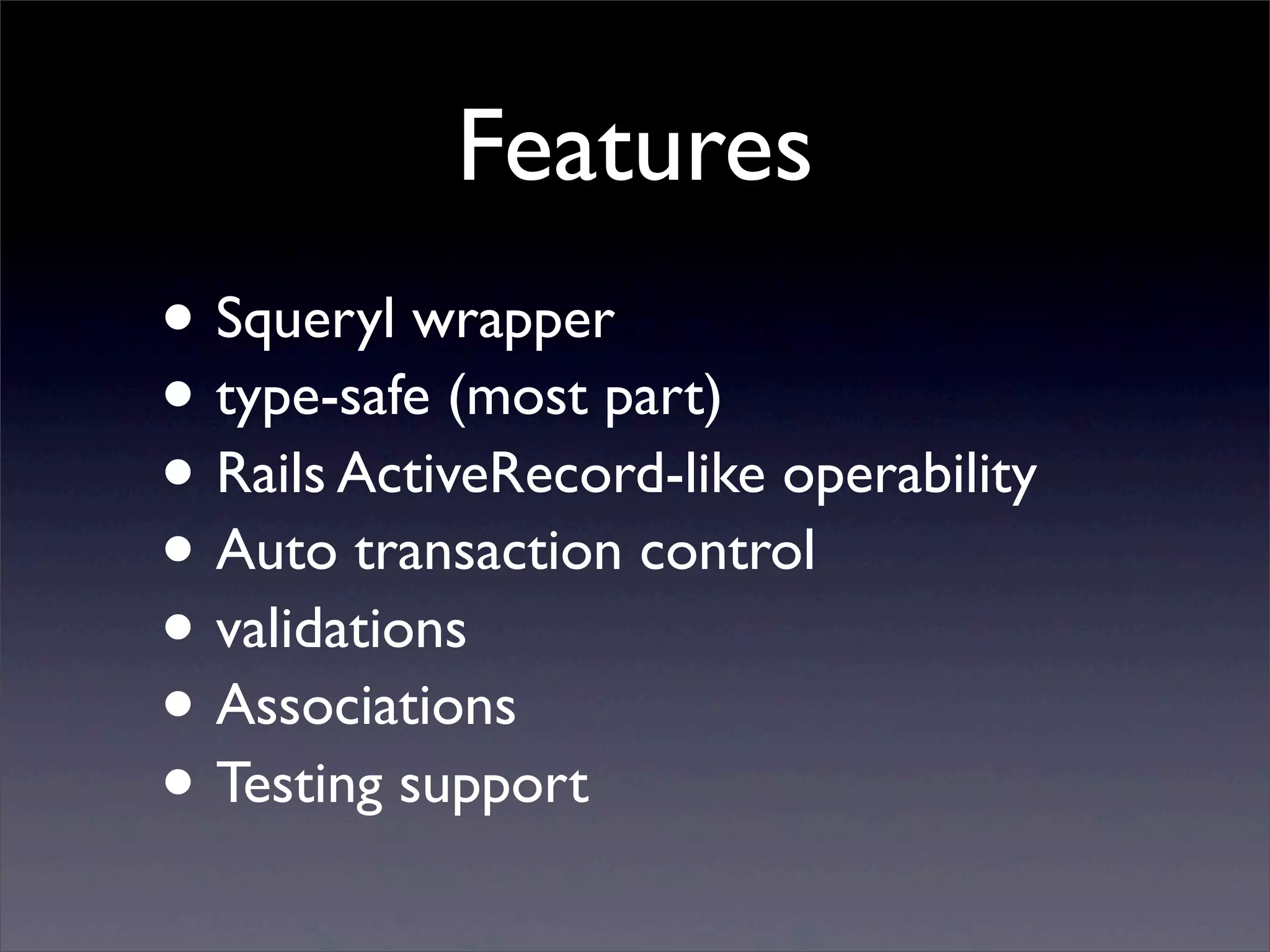
 -> row[String](“name”)
).toList](https://image.slidesharecdn.com/scala-activerecord-130624144236-phpapp02/75/Scala-active-record-9-2048.jpg)

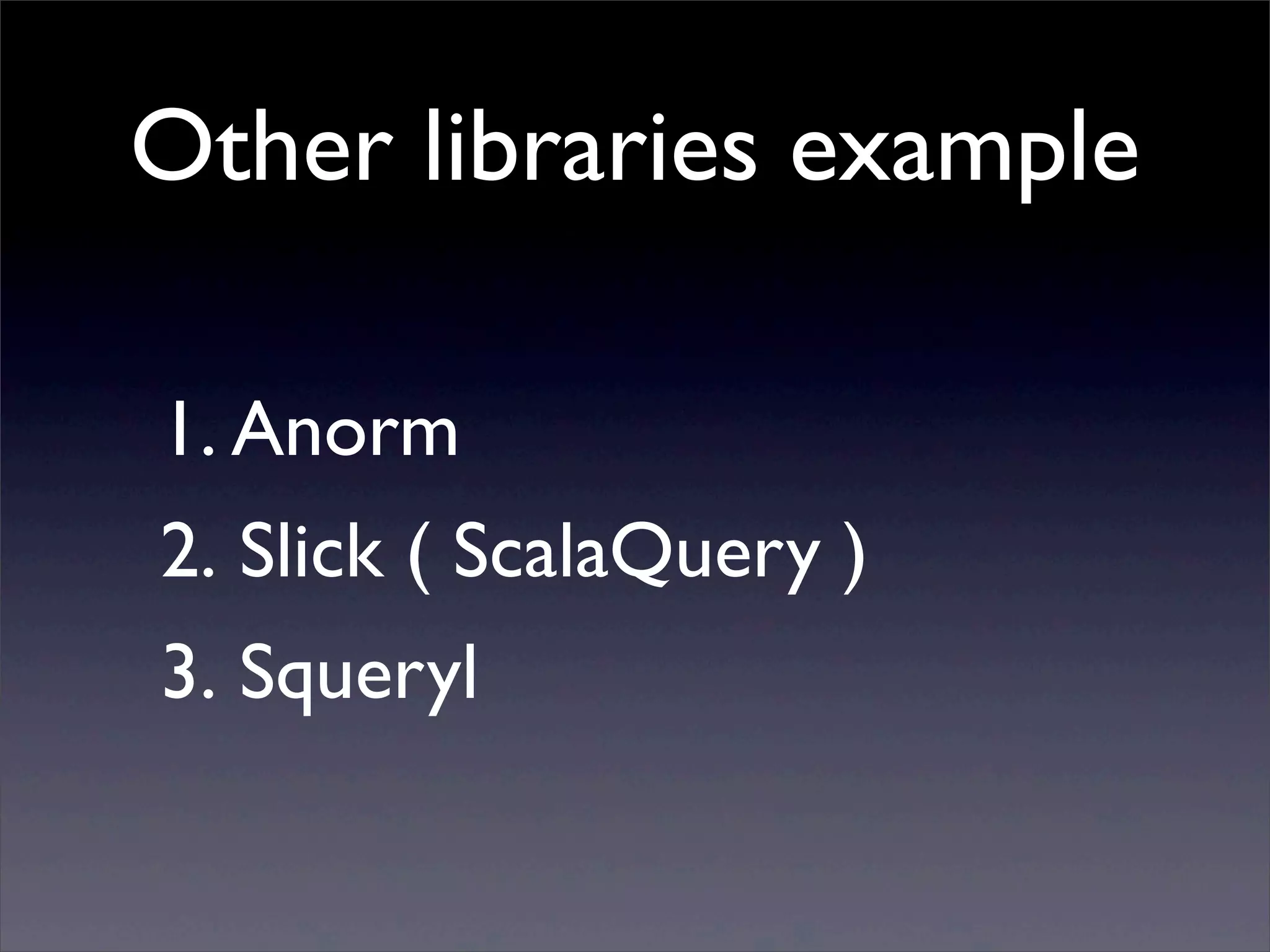
![1.Anorm
• Anorm doesn’t have the Model layer.
• Have to define similar methods in each
Class.
case class Person(id:Pk[Long], name:String)
object Person {
! def create(person:Person):Unit = {
! ! DB.withConnection { implicit connection =>
! ! ! SQL("insert int person(name) values ({name}")
! ! ! ! .on('name -> person.name)
! ! ! ! .executeUpdate()
! ! }
! }
! ...
}](https://image.slidesharecdn.com/scala-activerecord-130624144236-phpapp02/75/Scala-active-record-12-2048.jpg)
![2. Slick ( ScalaQuery )
• Query Interface is good.
• Definding tables syntax is redundant.
• Have to define the mapping between table
and model in each table.
case class Member(id:Int, name:String, email:Option[String])
object Members extends Table[Member]("MEMBERS") {
! def id = column[Int]("ID", O.PrimaryKey, O.AutoInc)
! def name = column[String]("Name")
! def email = column[Option[String]]("EMAIL")
! def * = id.? ~ name ~ email <> (Member, Member.unapply _)
}](https://image.slidesharecdn.com/scala-activerecord-130624144236-phpapp02/75/Scala-active-record-13-2048.jpg)
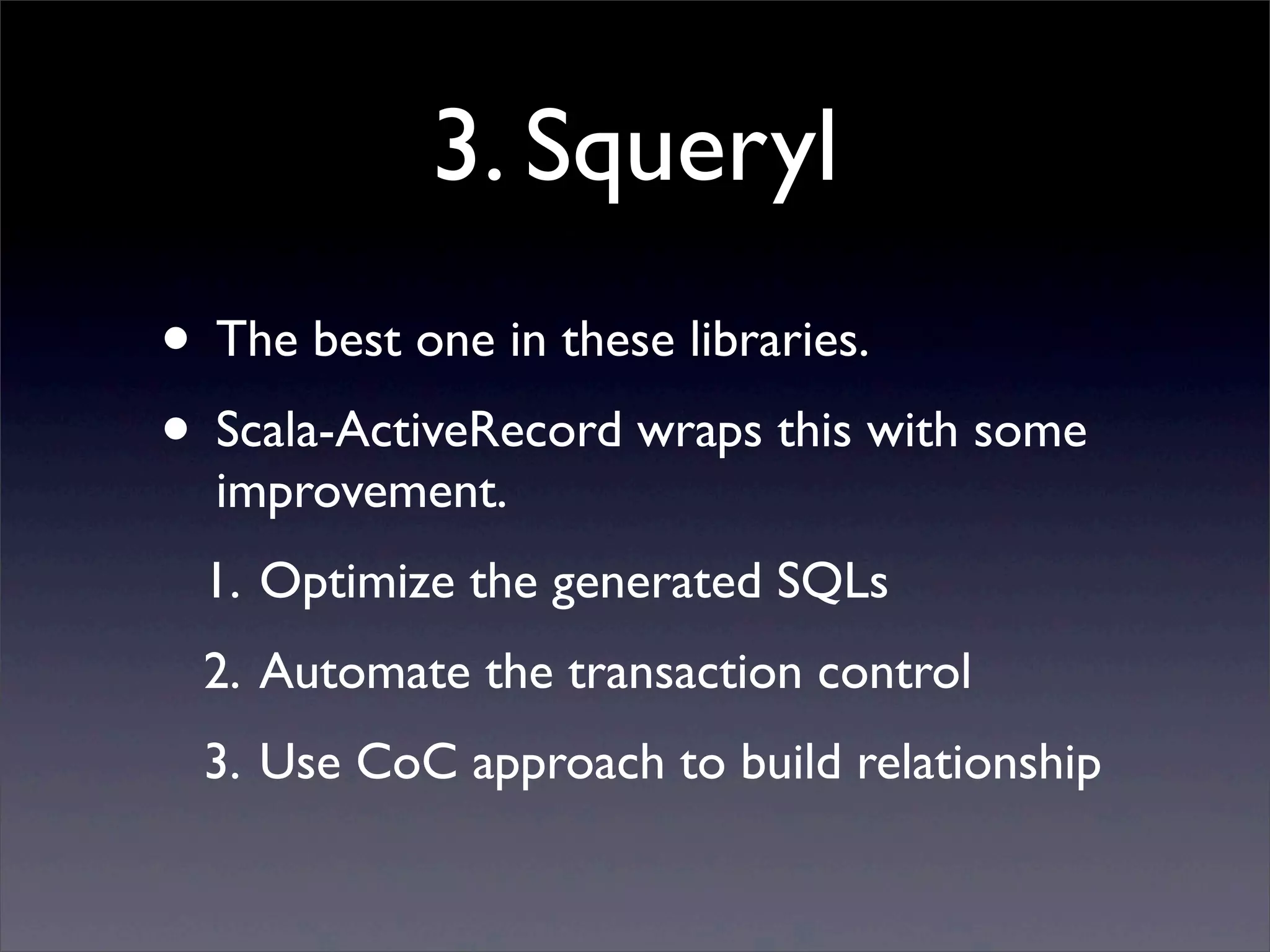
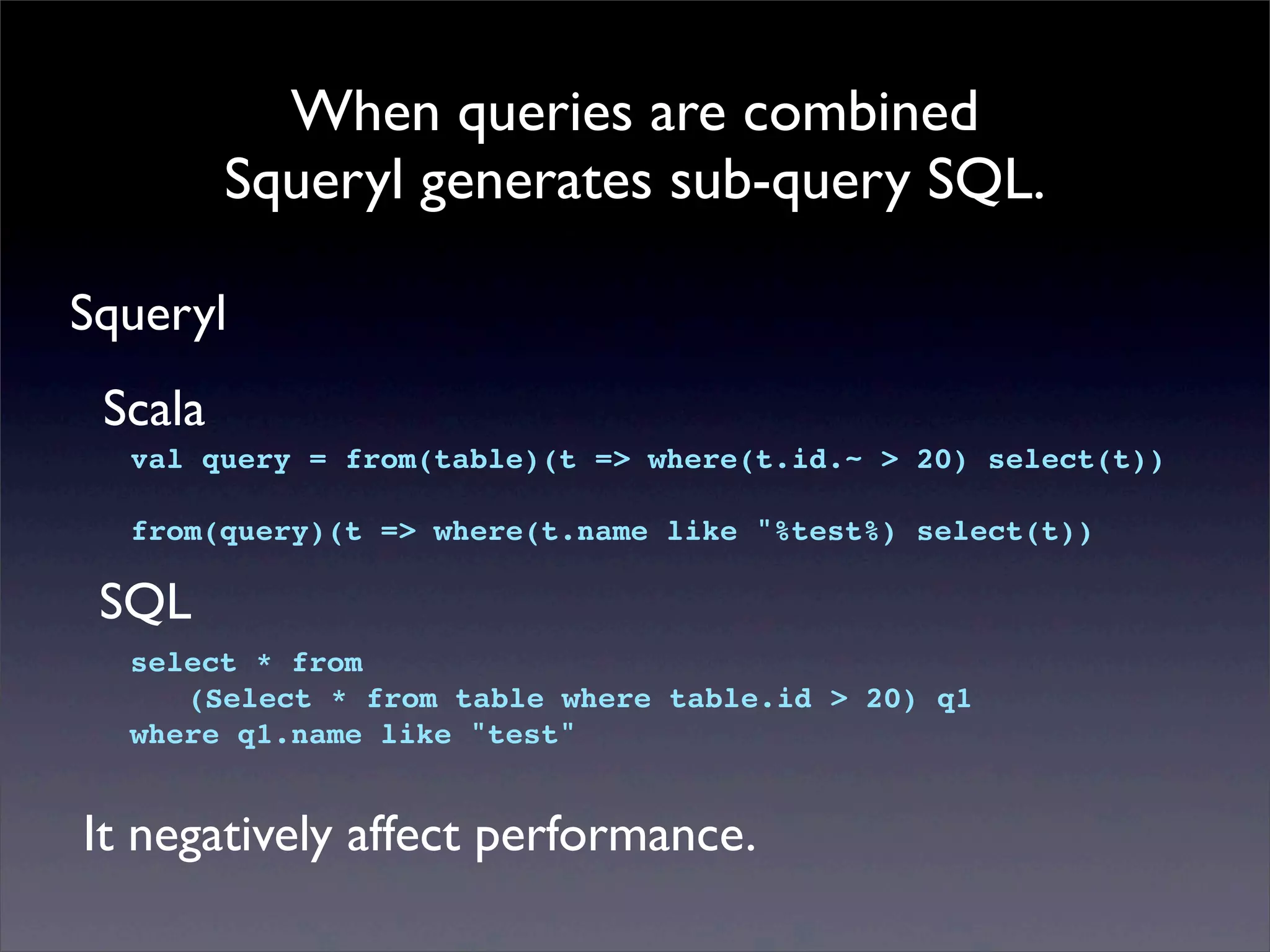
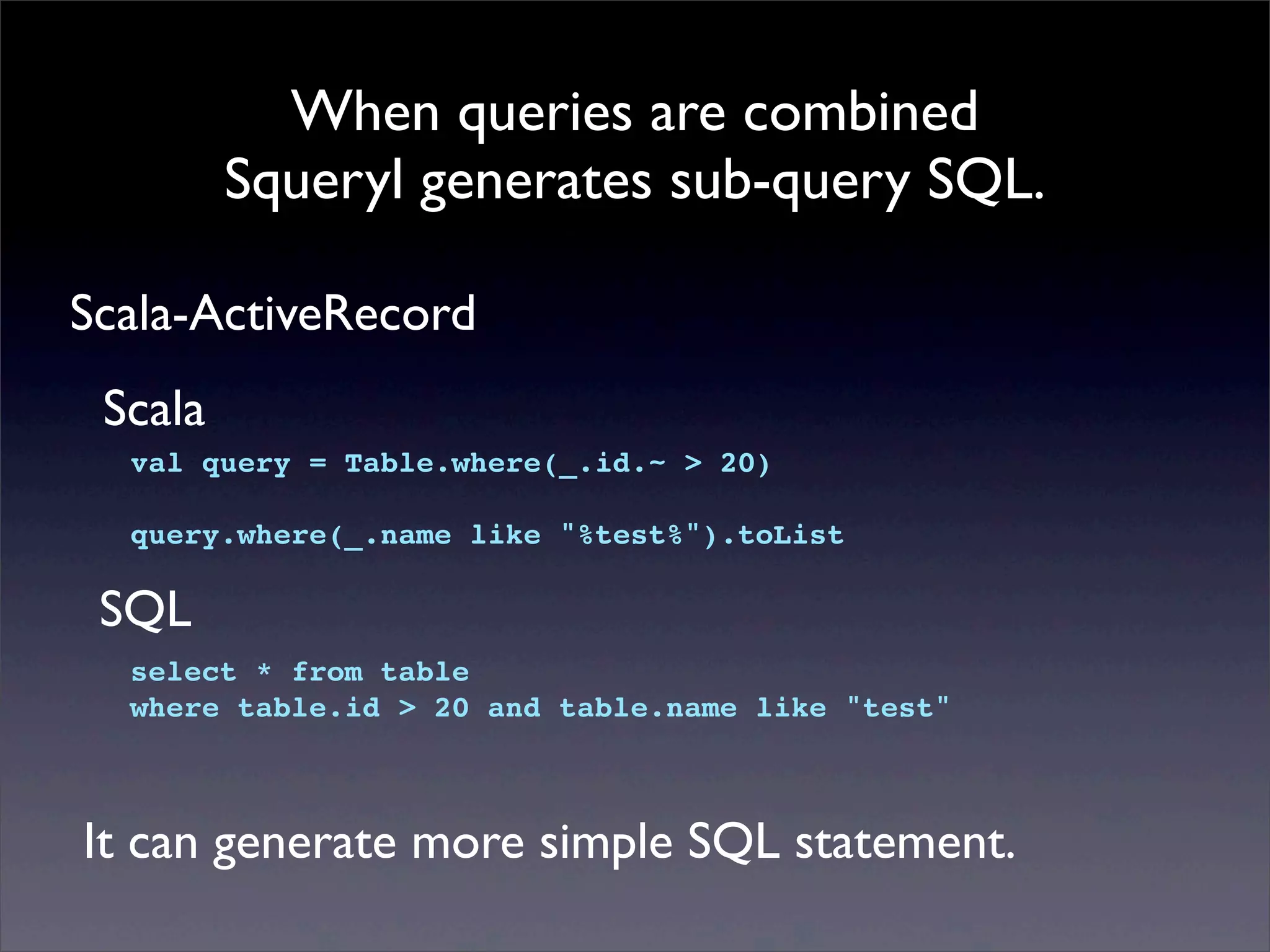
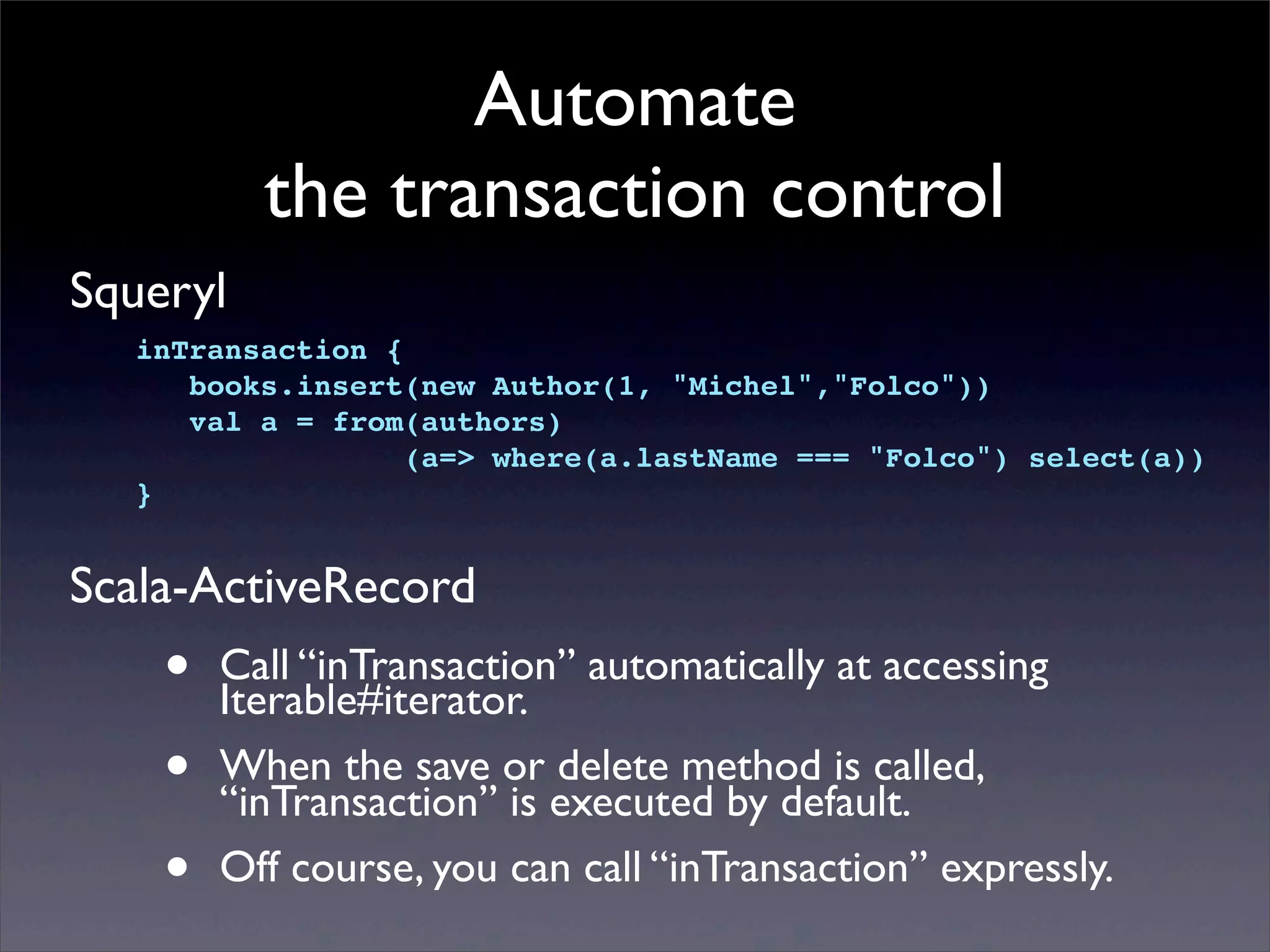
![Use CoC approach to
build relationship.
Squeryl
object Schema extends Schema{
! val foo = table[Foo]
! val bar = table[Bar]
! val fooToBar = oneToManyRelation(Foo, Bar).via(
! ! (f,b) => f.barId === b.id
! )
}
class Foo(var barId:Long) extends SomeEntity {
! lazy val bar:ManyToOne[Bar] = schema.fooToBar.right(this)
}
class Bar(var bar:String) extends SomeEntity {
! lazy val foos:OneToMany[Foo] = schema.fooToBar.left(this)
}](https://image.slidesharecdn.com/scala-activerecord-130624144236-phpapp02/75/Scala-active-record-18-2048.jpg)
![Use CoC approach to
build relationship.
Scala-ActiveRecord
object Table extends ActiveRecordTabels {
! val foo = table[Foo]
! val bar = table[Bar]
}
class Foo(var barId:Long) extends ActiveRecord {
! lazy val bar = belongsTo[Bar]
}
class Bar(var bar:String) extends ActiveRecord {
! lazy val foos = hasMany[Foo]
}](https://image.slidesharecdn.com/scala-activerecord-130624144236-phpapp02/75/Scala-active-record-19-2048.jpg)

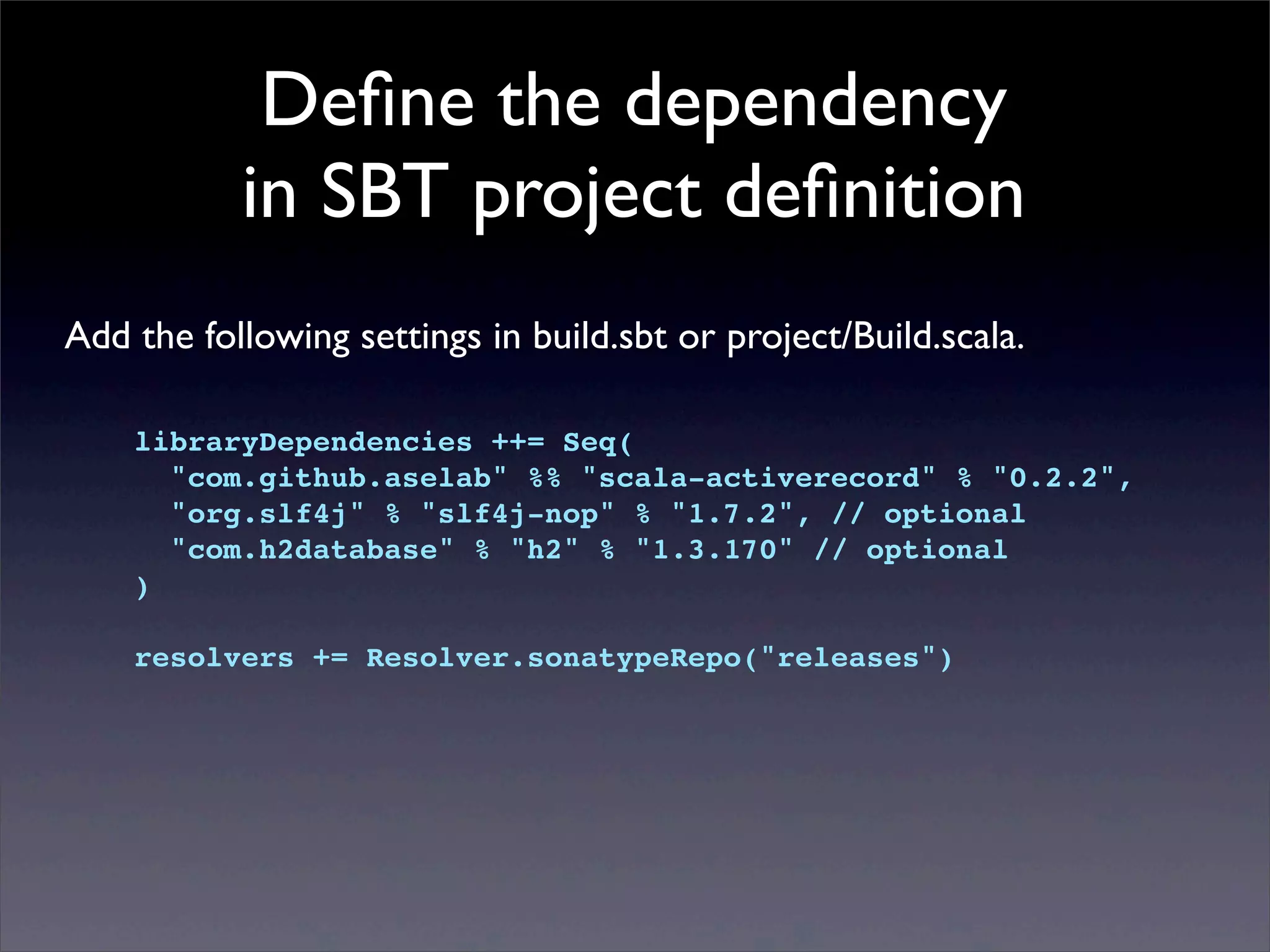
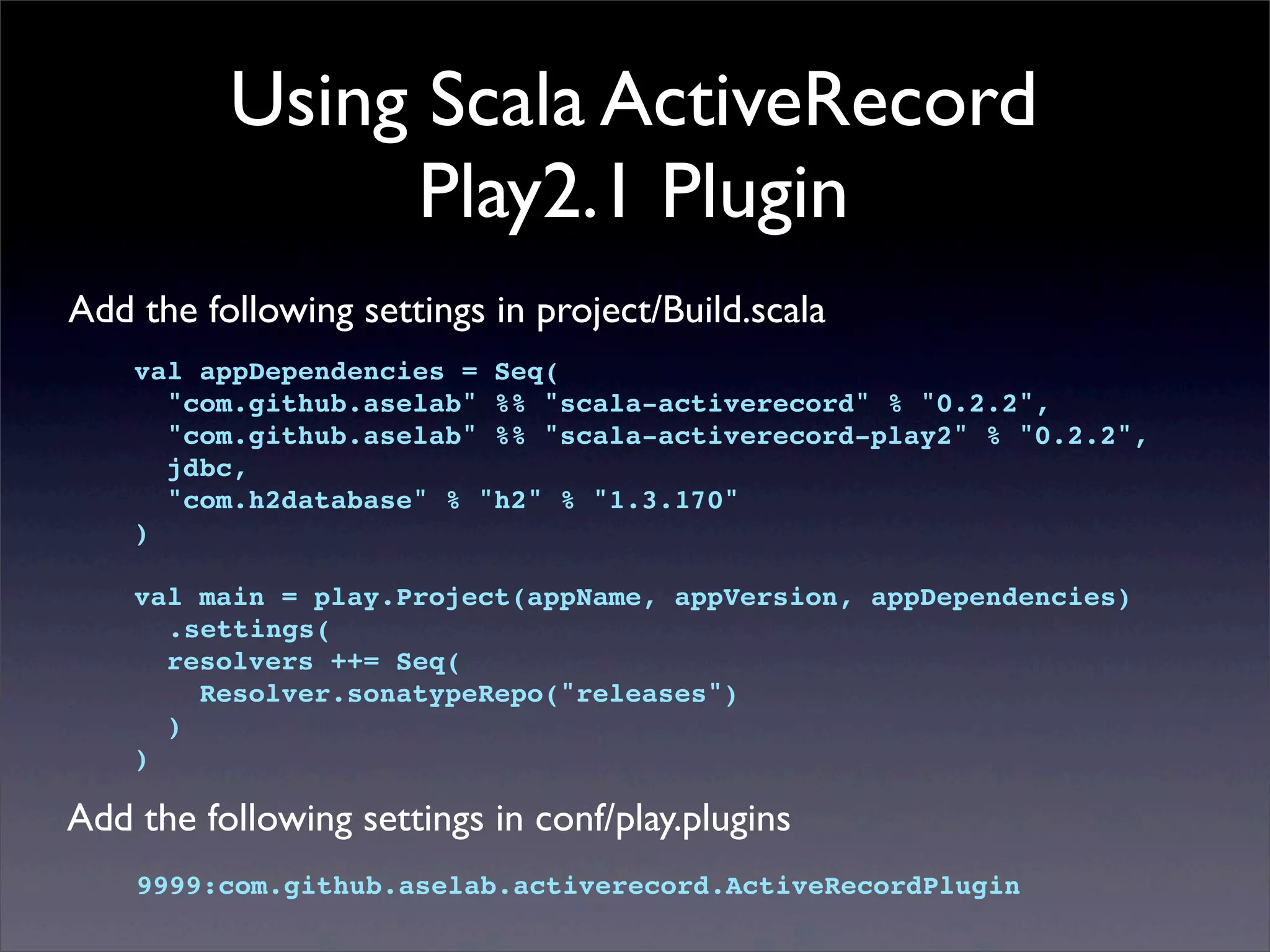
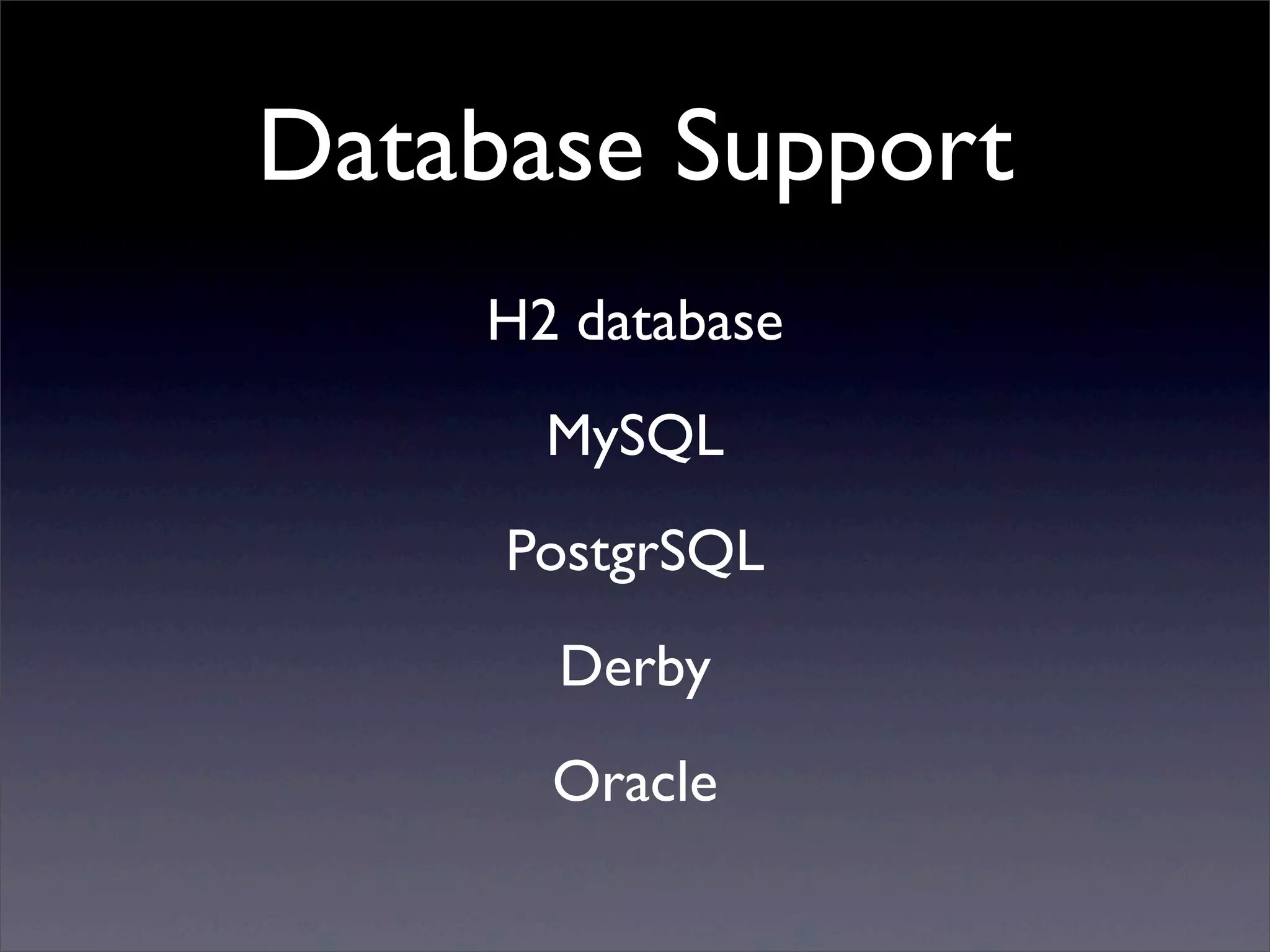

![Model implementation
case class Person(var name:String, var age:Int)
! extends ActiveRecord
object Person
! extends ActiveRecordCompanion[Person]
Schema definition
object Tables extends ActiveRecordTable {
! val people = table[Person]
}](https://image.slidesharecdn.com/scala-activerecord-130624144236-phpapp02/75/Scala-active-record-25-2048.jpg)

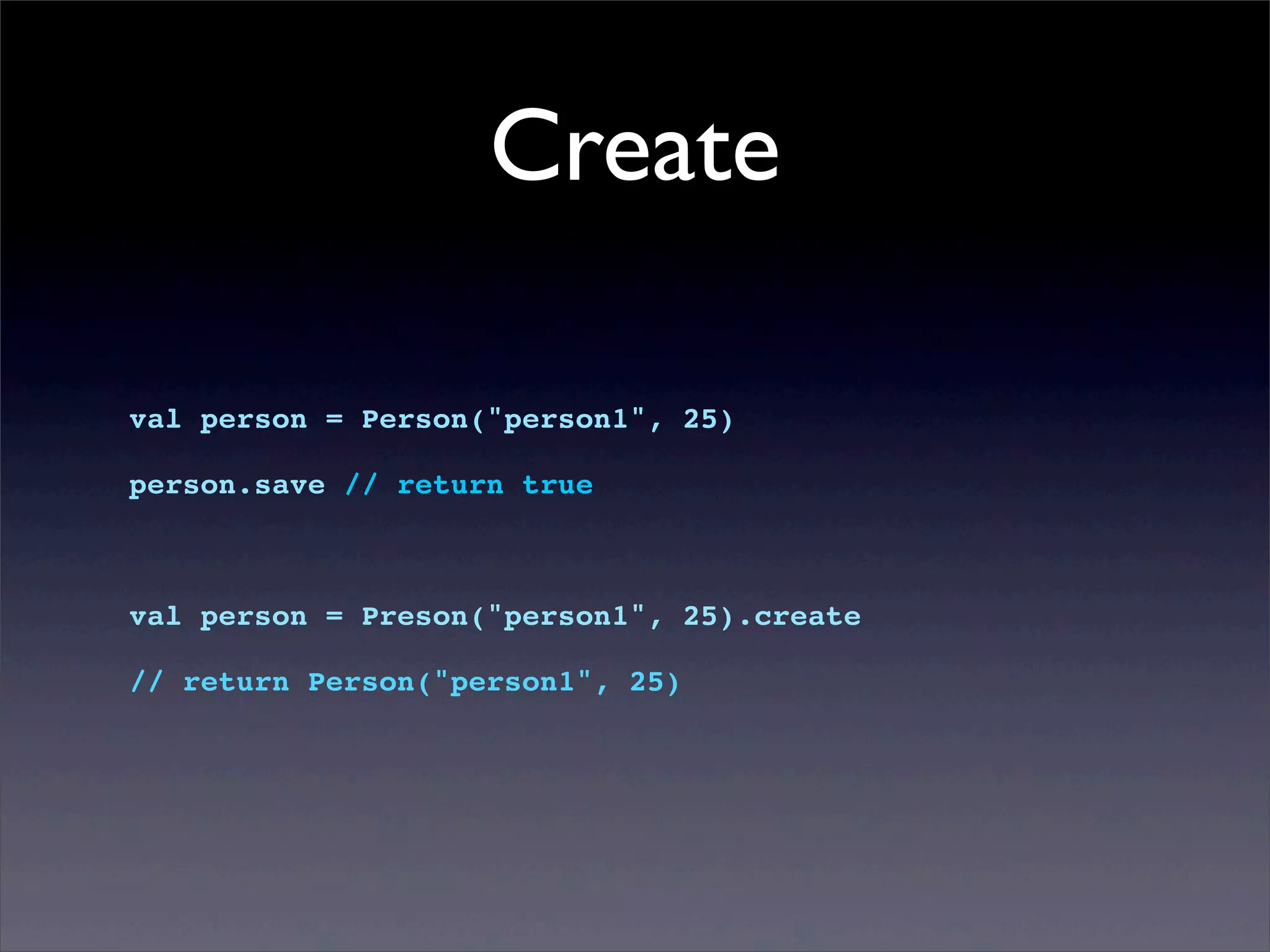
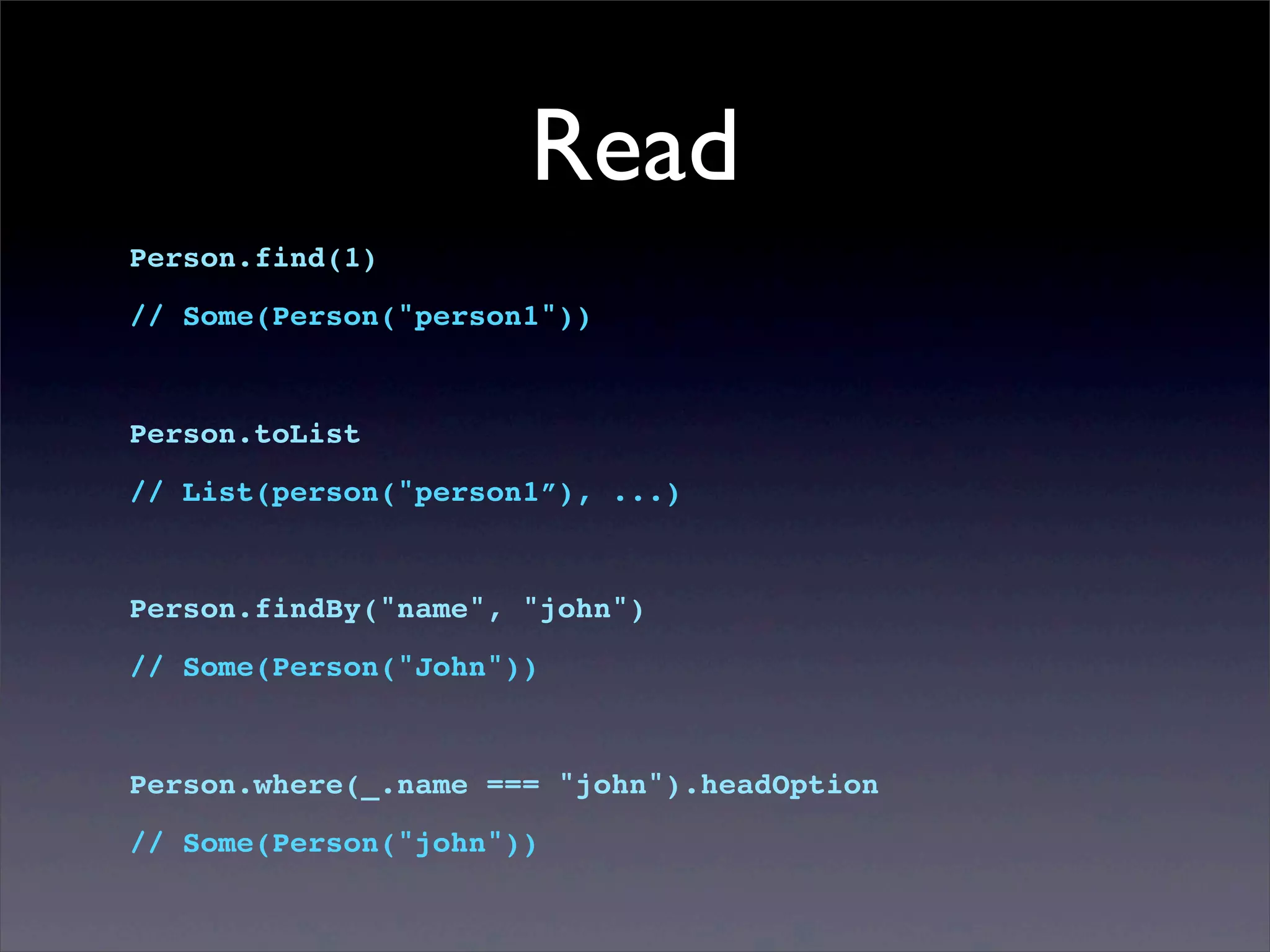
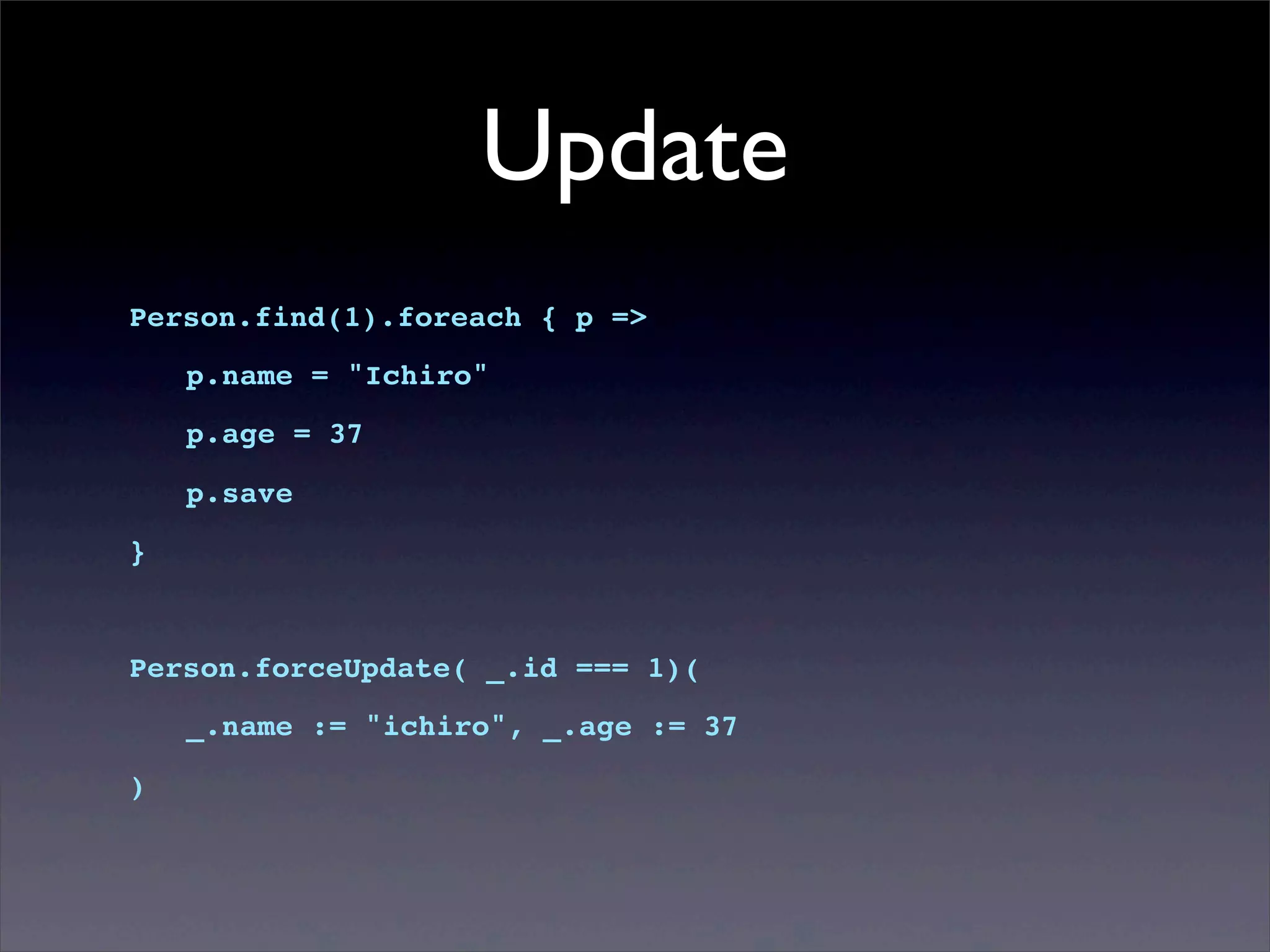
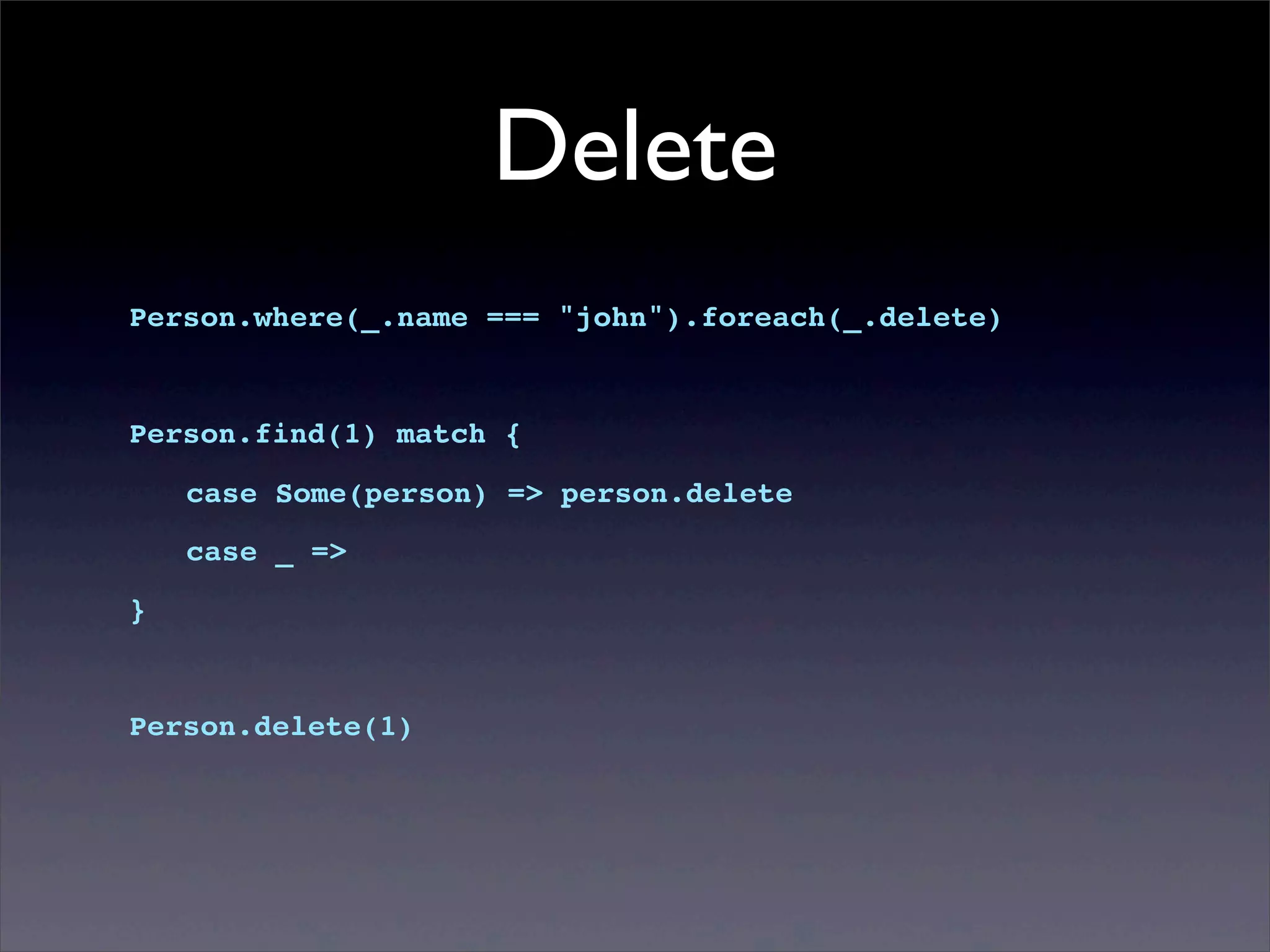

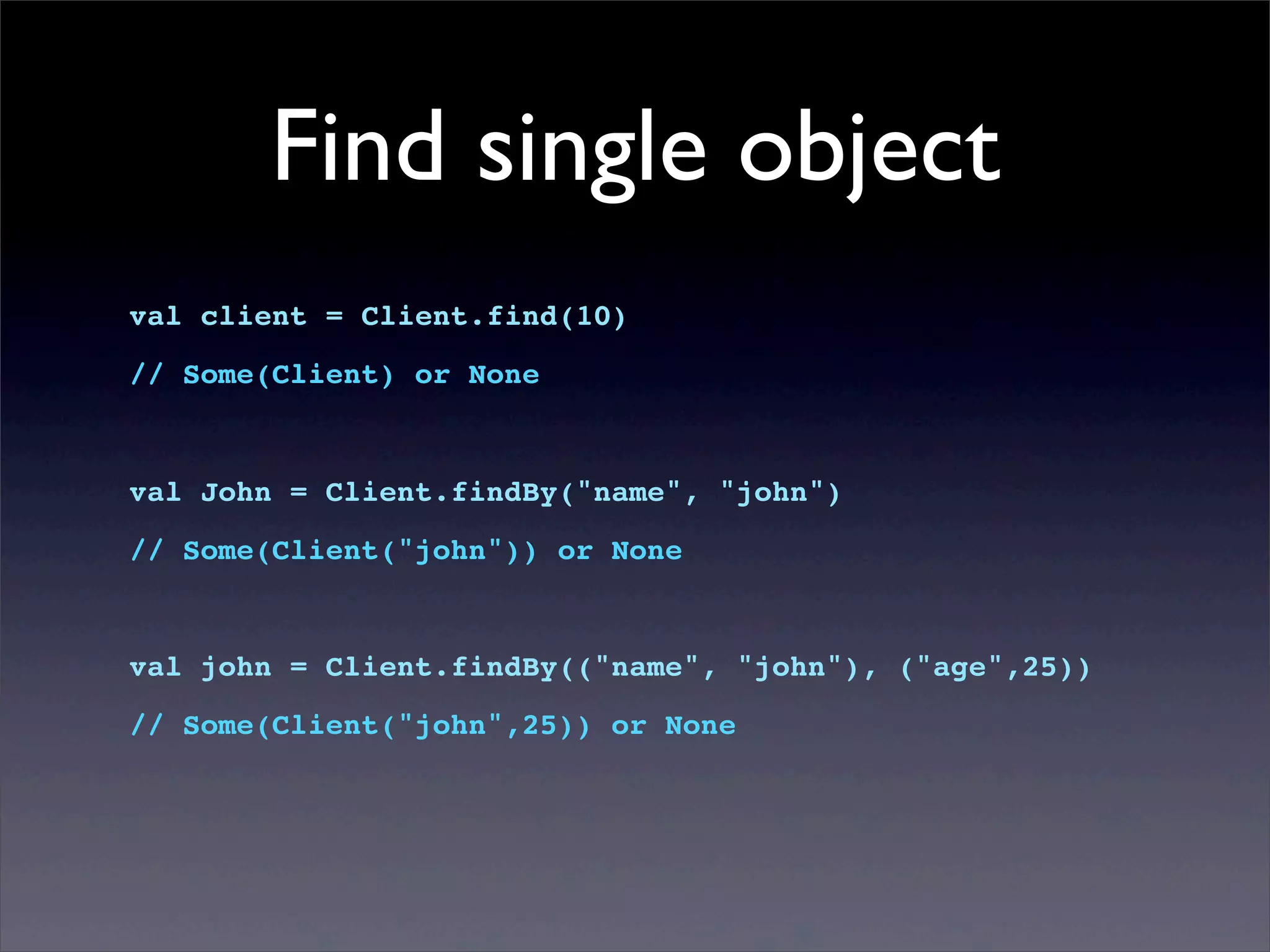
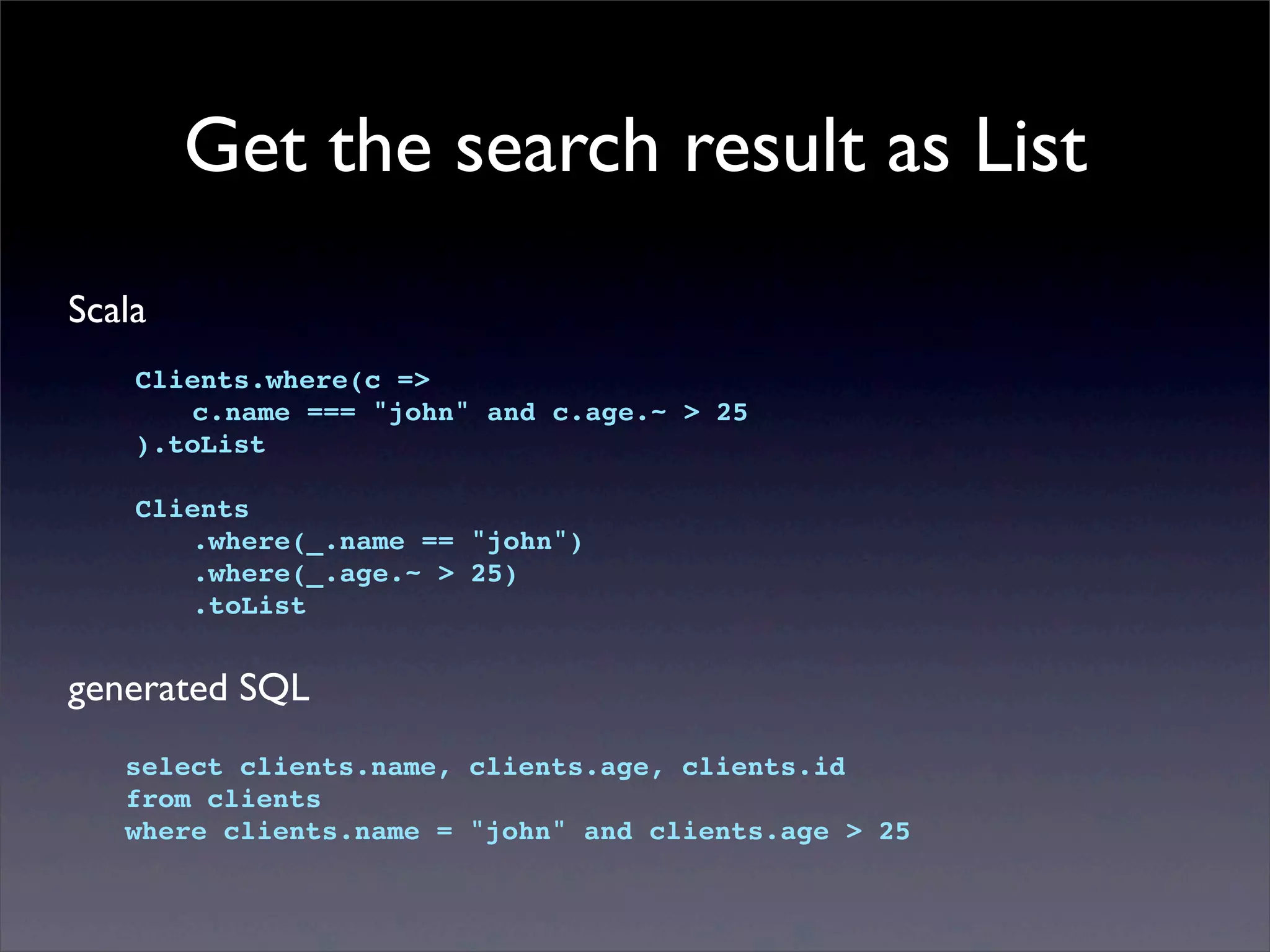
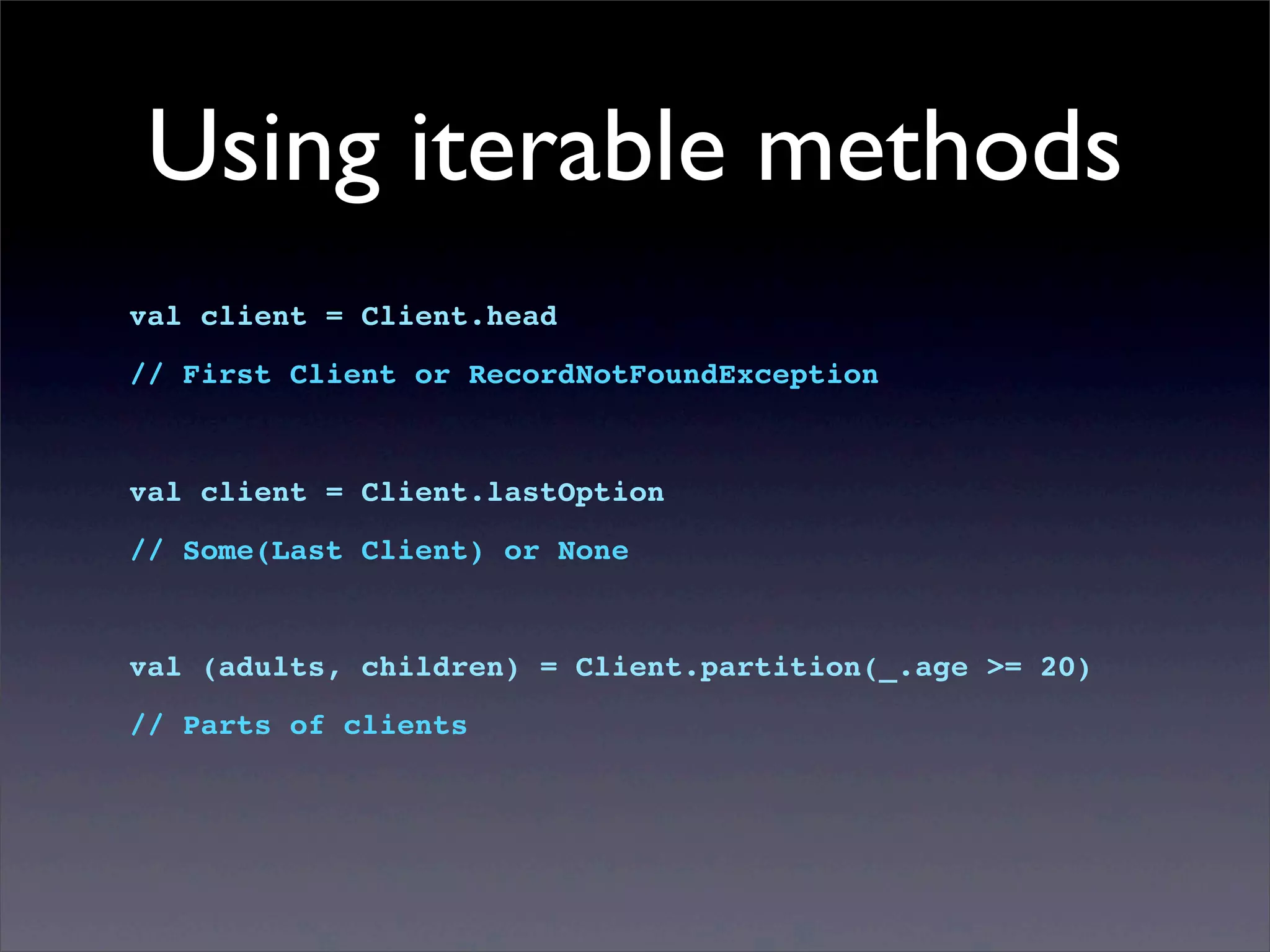
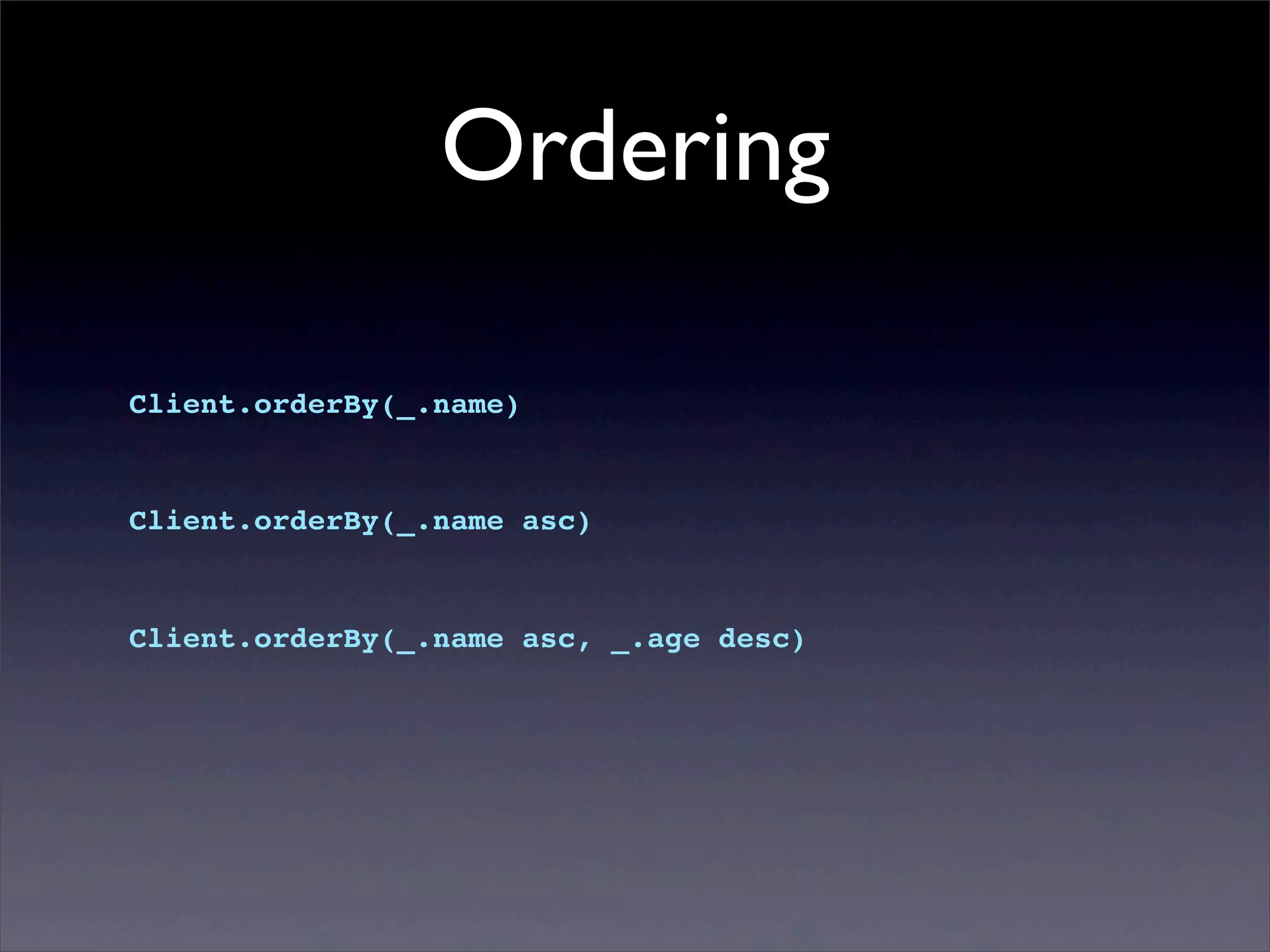
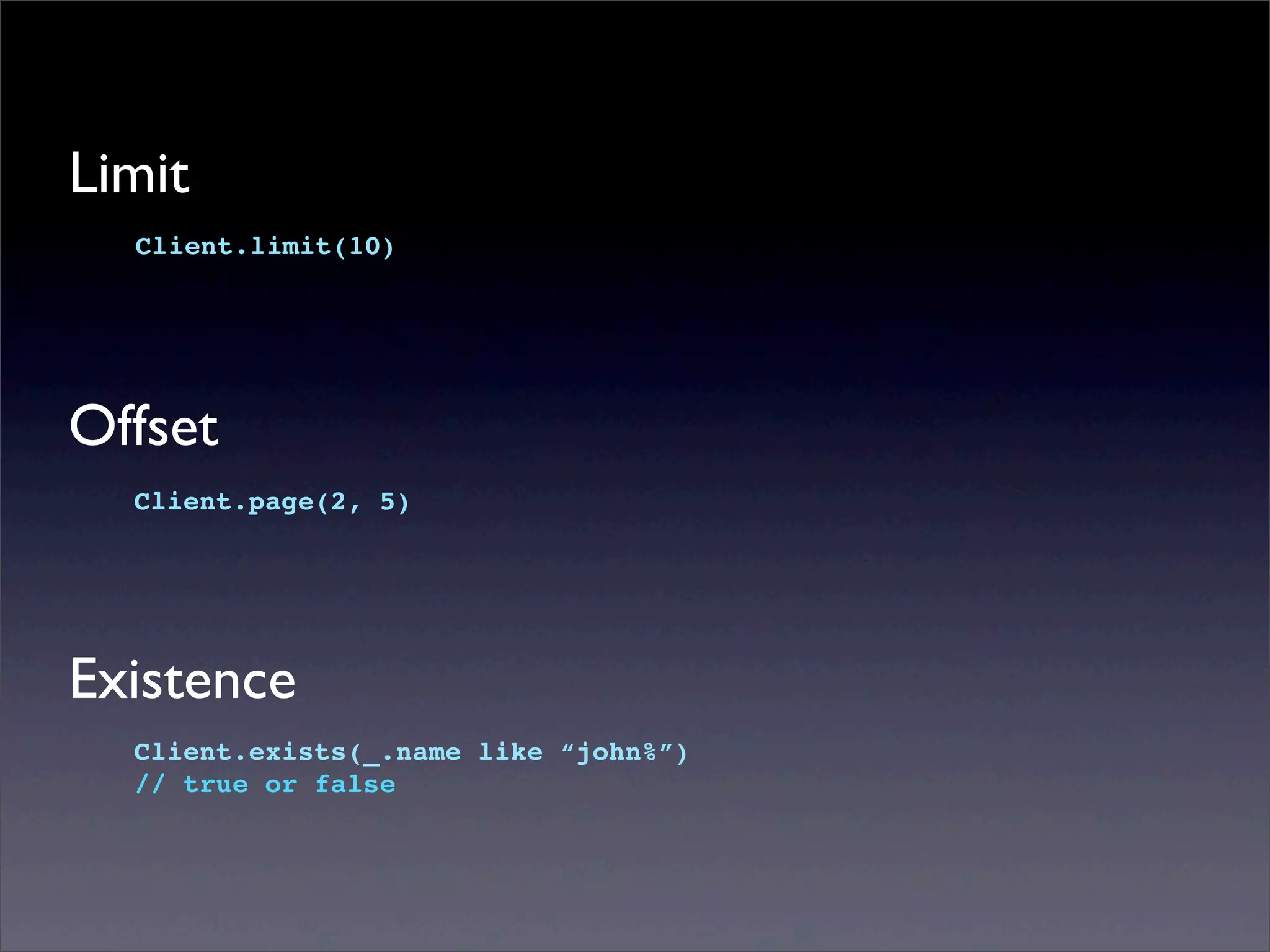
![Specify selected fields
Client.select(_.name).toList
// List[String]
Client.select(c => (c.name, c.age)).toList
// List[(String, Int)]](https://image.slidesharecdn.com/scala-activerecord-130624144236-phpapp02/75/Scala-active-record-37-2048.jpg)
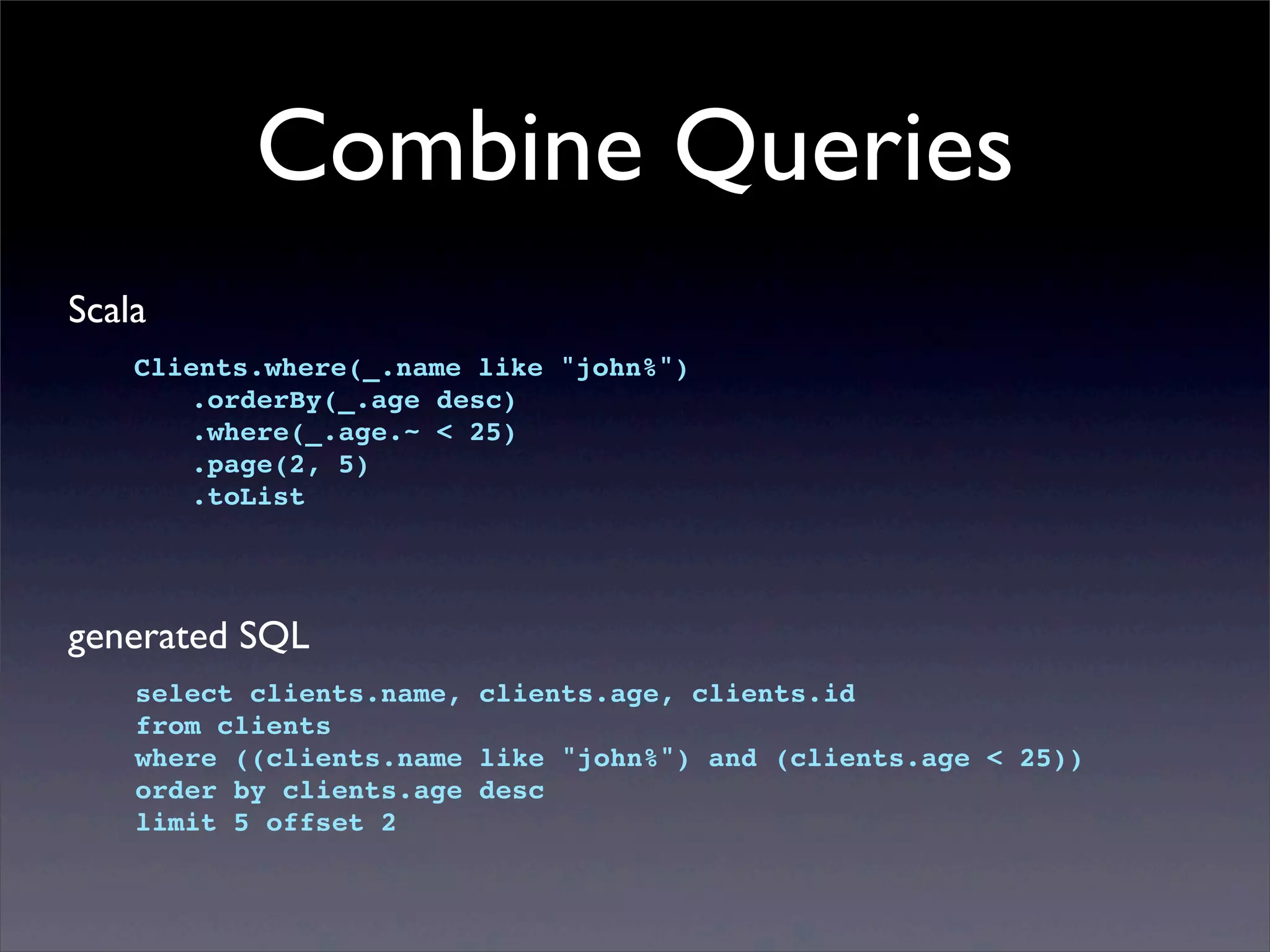
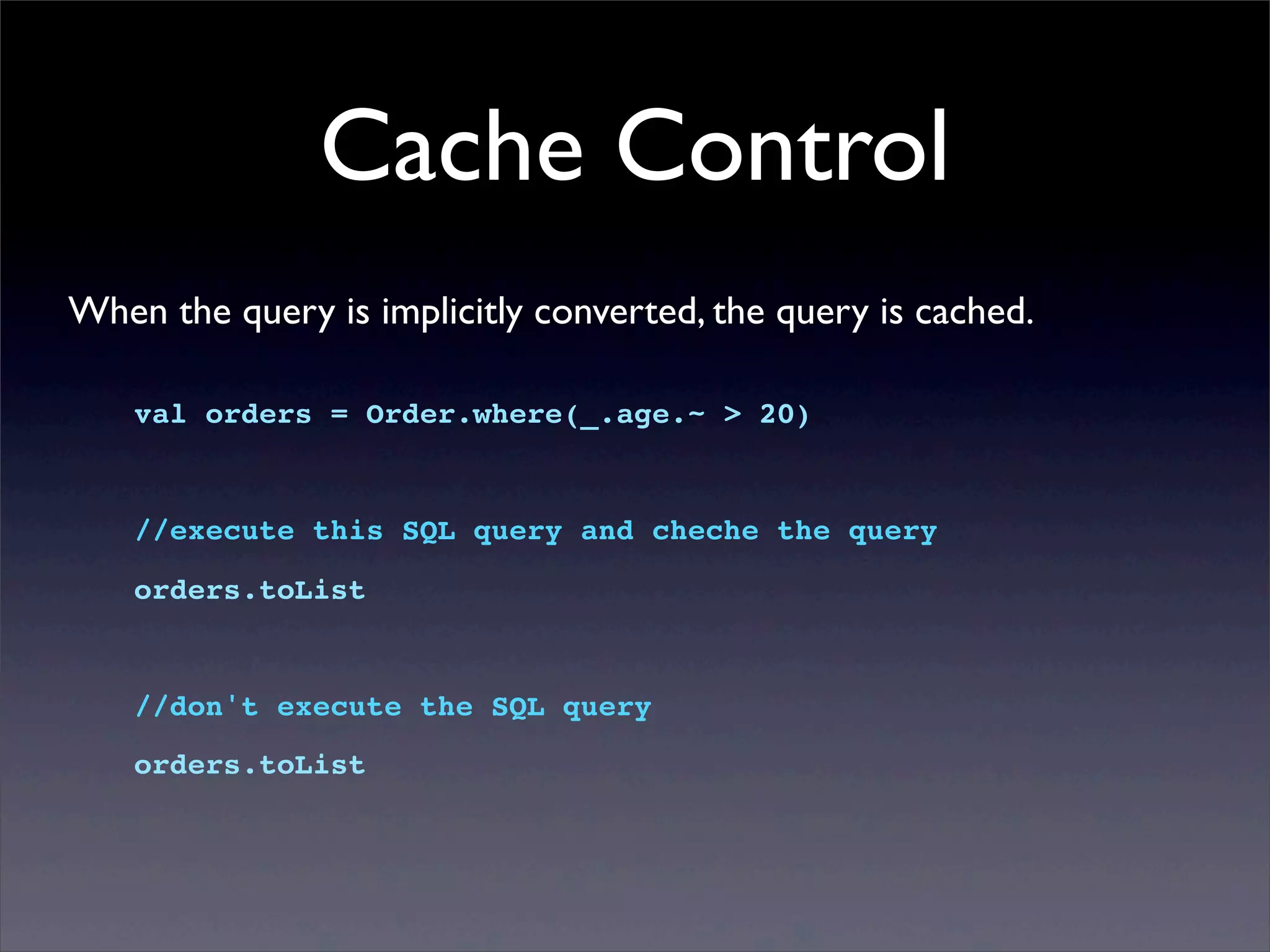

![Annotation-based
Validation
case class User(
! @Required name:String,
! @Length(max=20) profile:String,
! @Range(min=0, max=150) age:Int
) extends ActiveRecord
Object User extends ActiveRecordCompanion[User]](https://image.slidesharecdn.com/scala-activerecord-130624144236-phpapp02/75/Scala-active-record-41-2048.jpg)
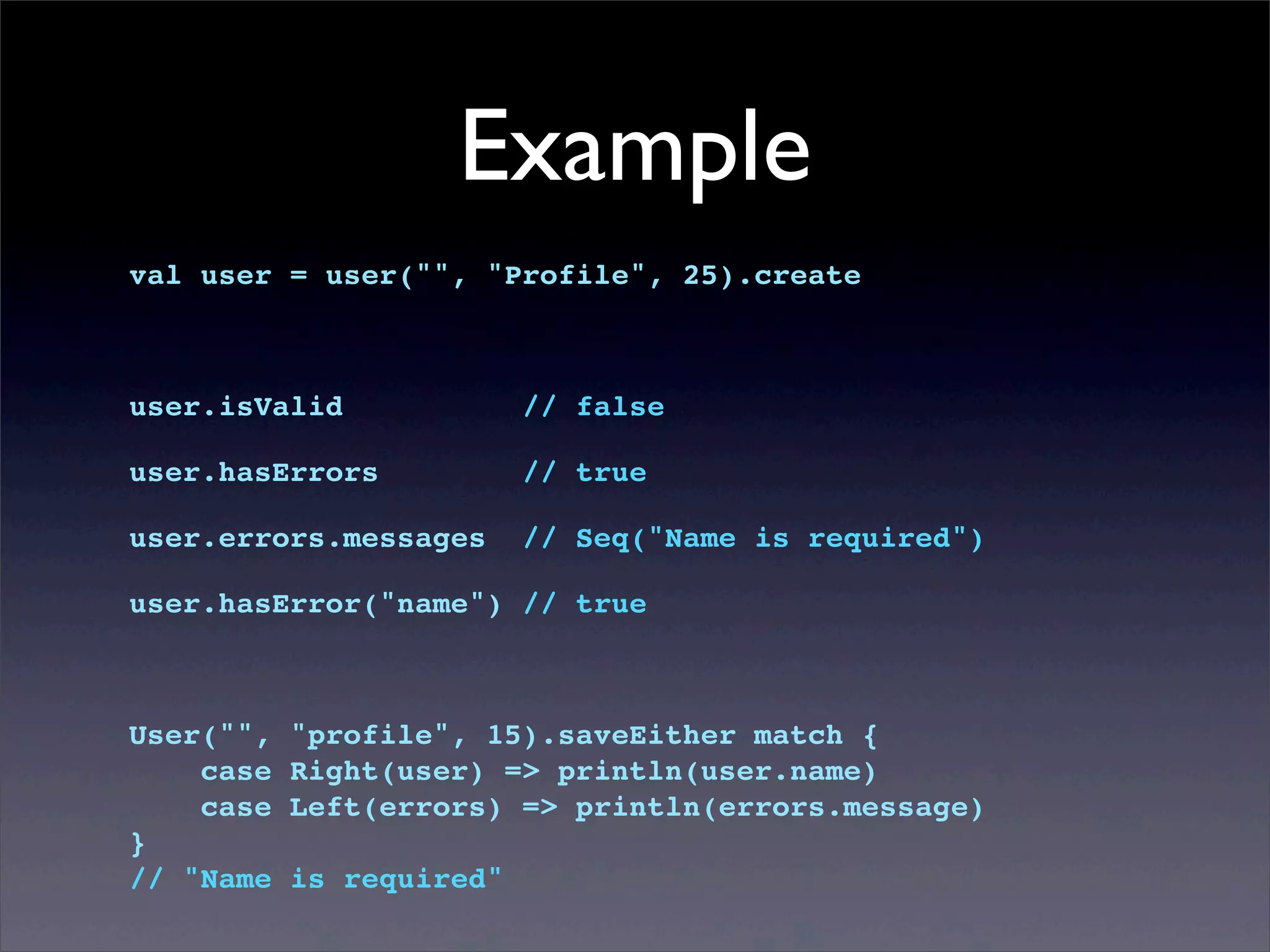

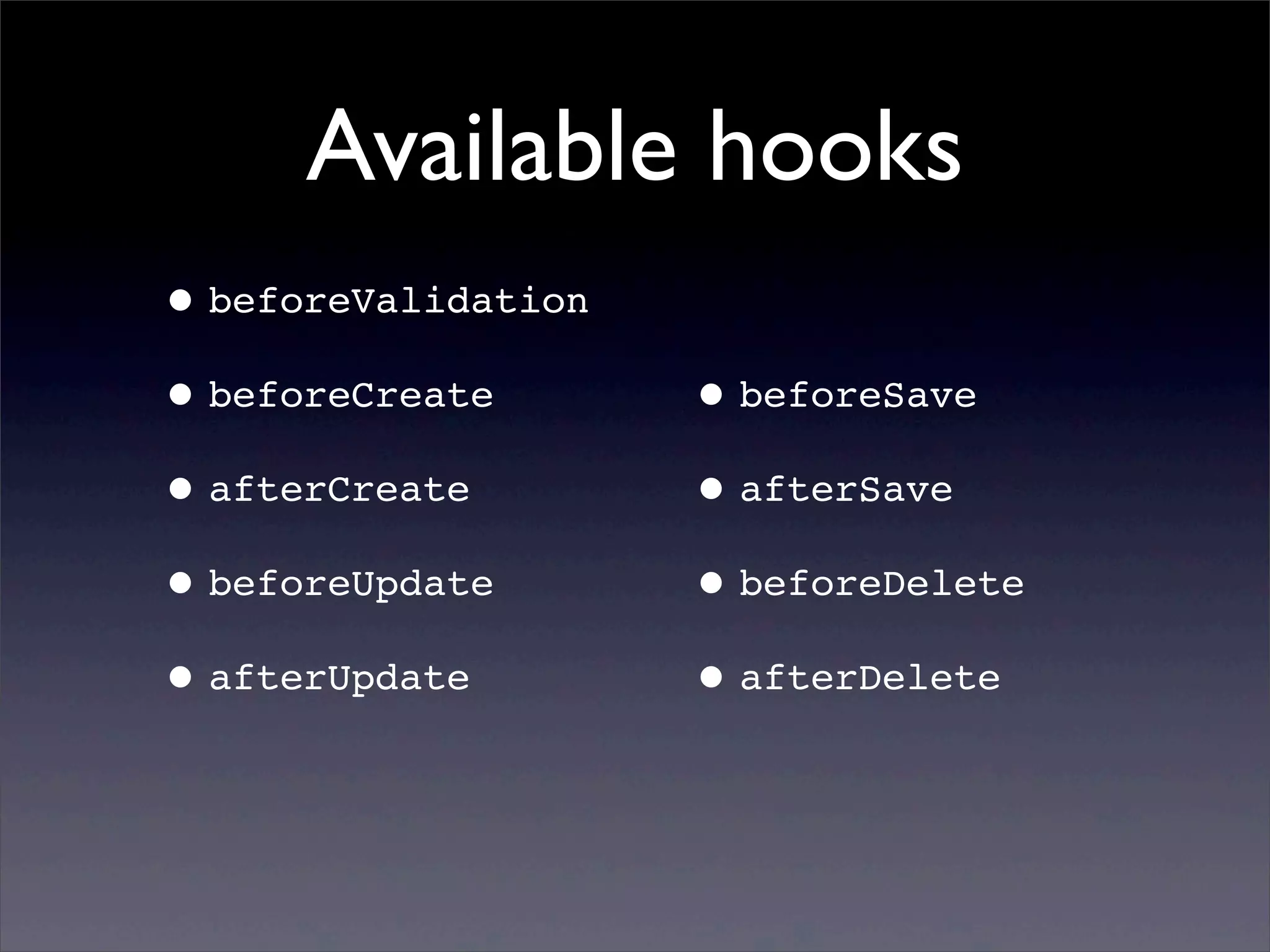
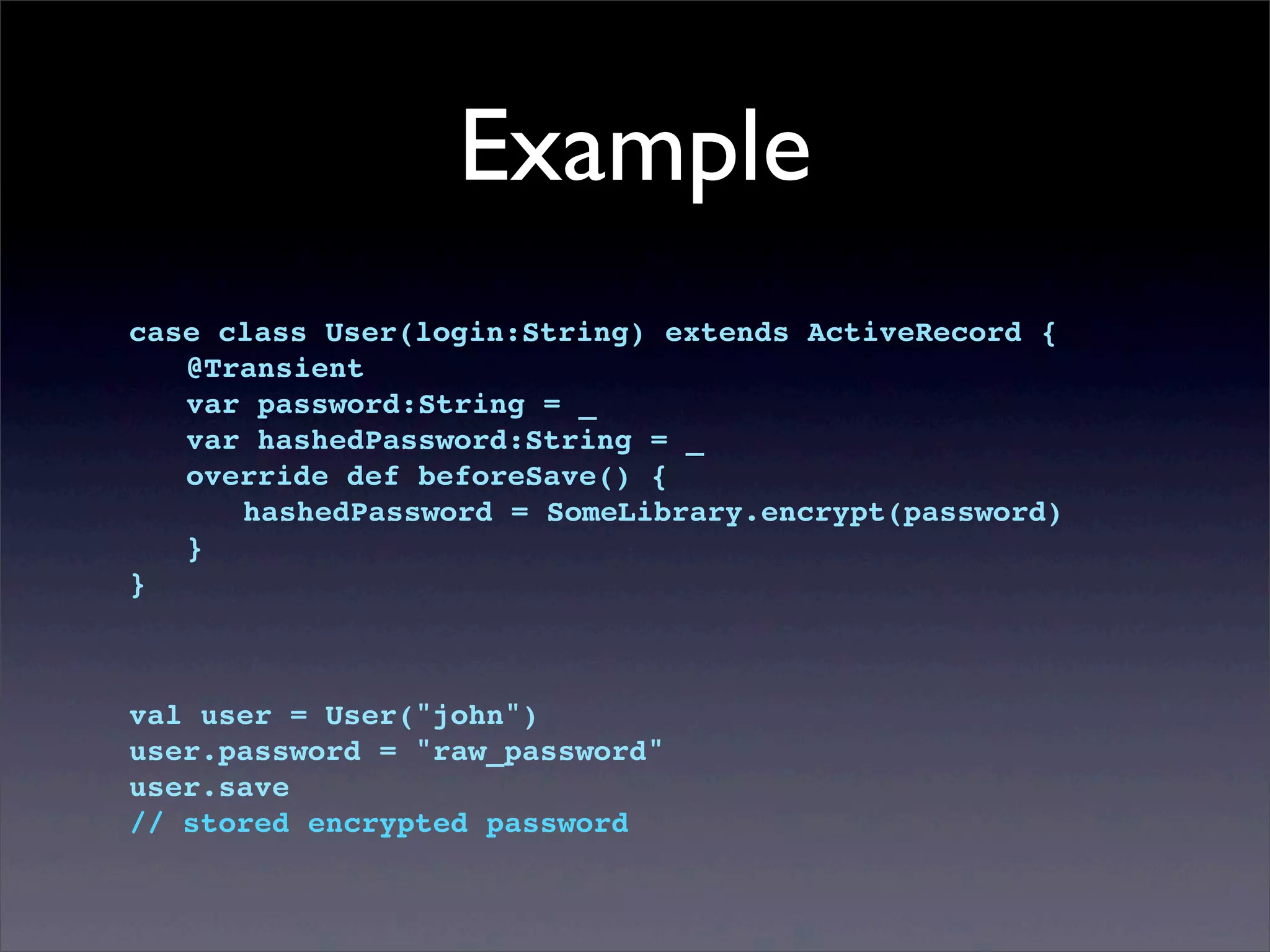

![One-to-Many
case class User(name:String) extends ActiveRecord {
! val groupId:Option[Long] = None
! lazy val group = belongsTo[Group]
}
case class Group(name:String) extends ActiveRecord {
! lazy val users = hasMany[User]
}
groups
id
name
users
id
group_id
name](https://image.slidesharecdn.com/scala-activerecord-130624144236-phpapp02/75/Scala-active-record-47-2048.jpg)
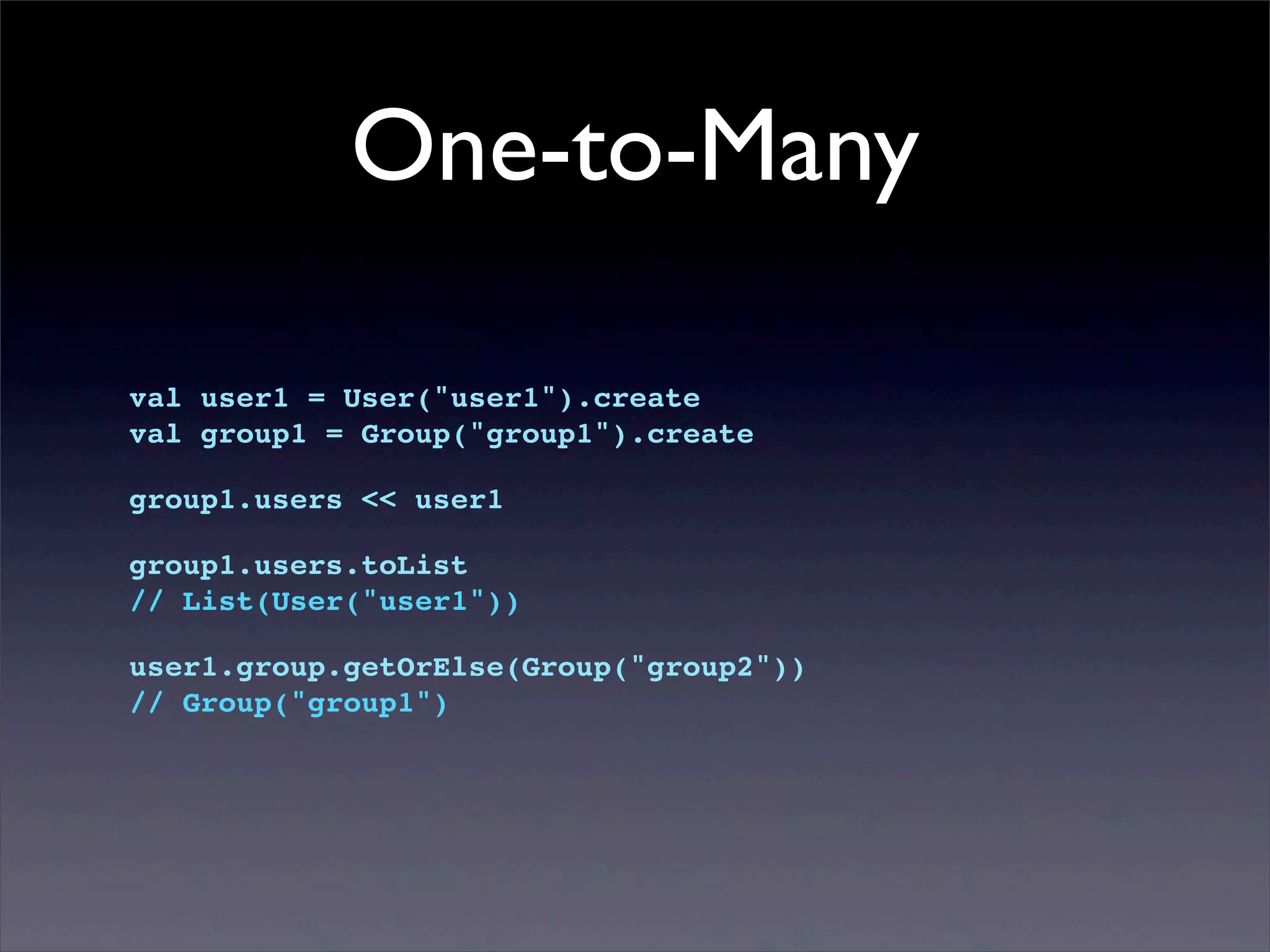
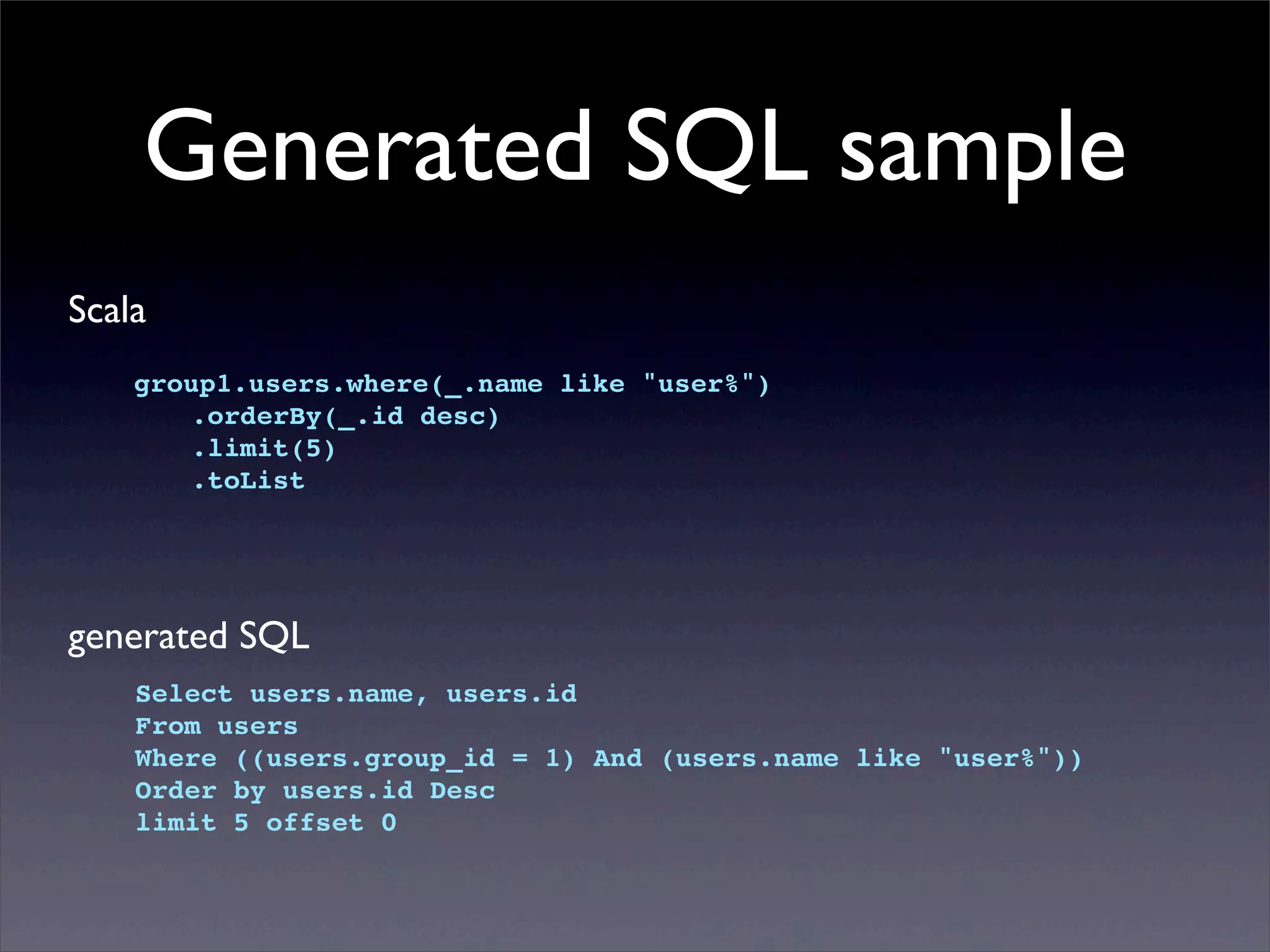
![Many-to-Many (HABTM)
case class User(name:String) extends ActiveRecord {
! lazy val groups = hasAndBelongsToMany[Group]
}
case class Group(name:String) extends ActiveRecord {
! lazy val users = hasAndBelongsToMany[user]
}
groups
id
name
groups_users
left_id
right_id
users
id
name](https://image.slidesharecdn.com/scala-activerecord-130624144236-phpapp02/75/Scala-active-record-50-2048.jpg)
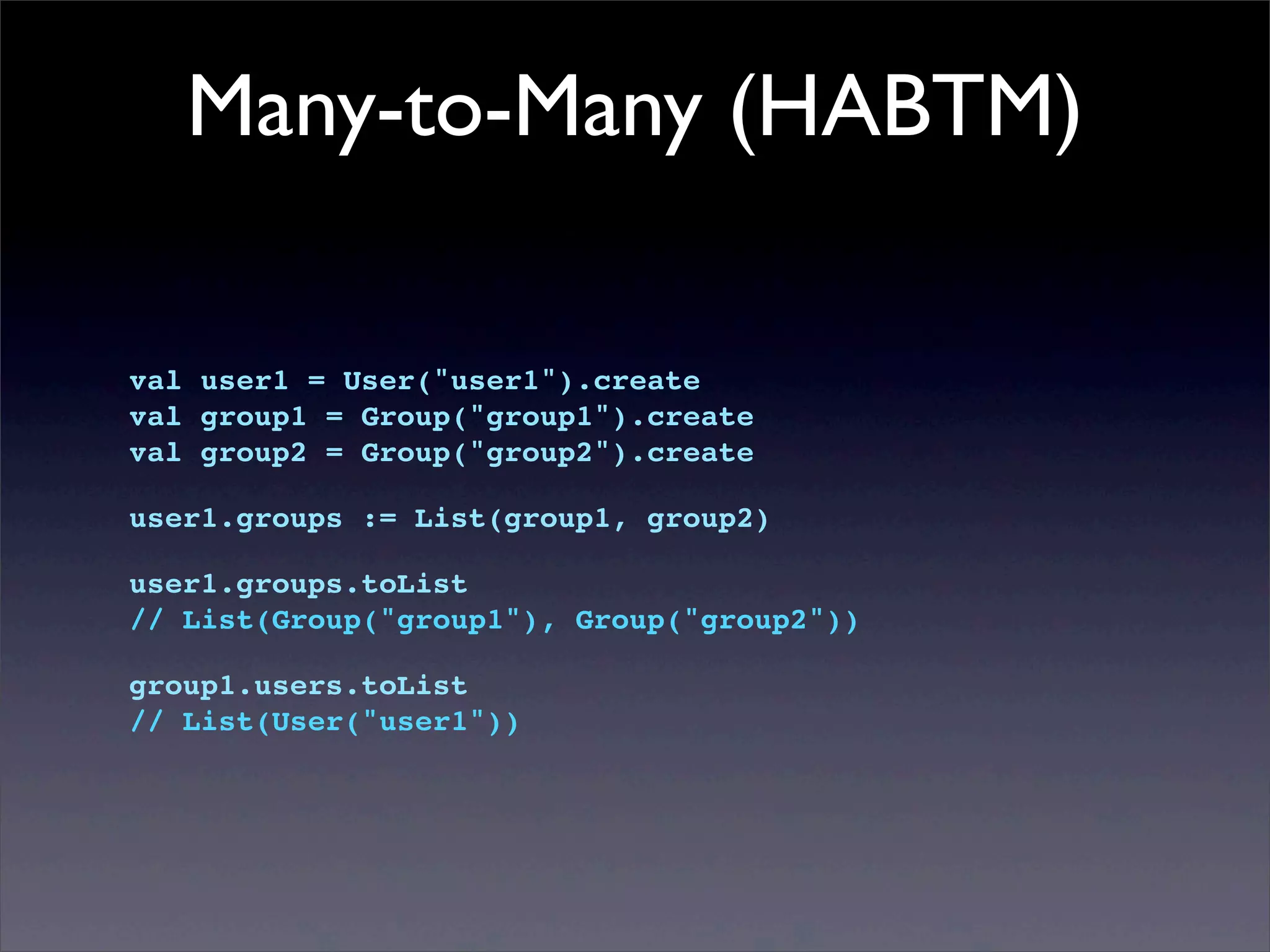
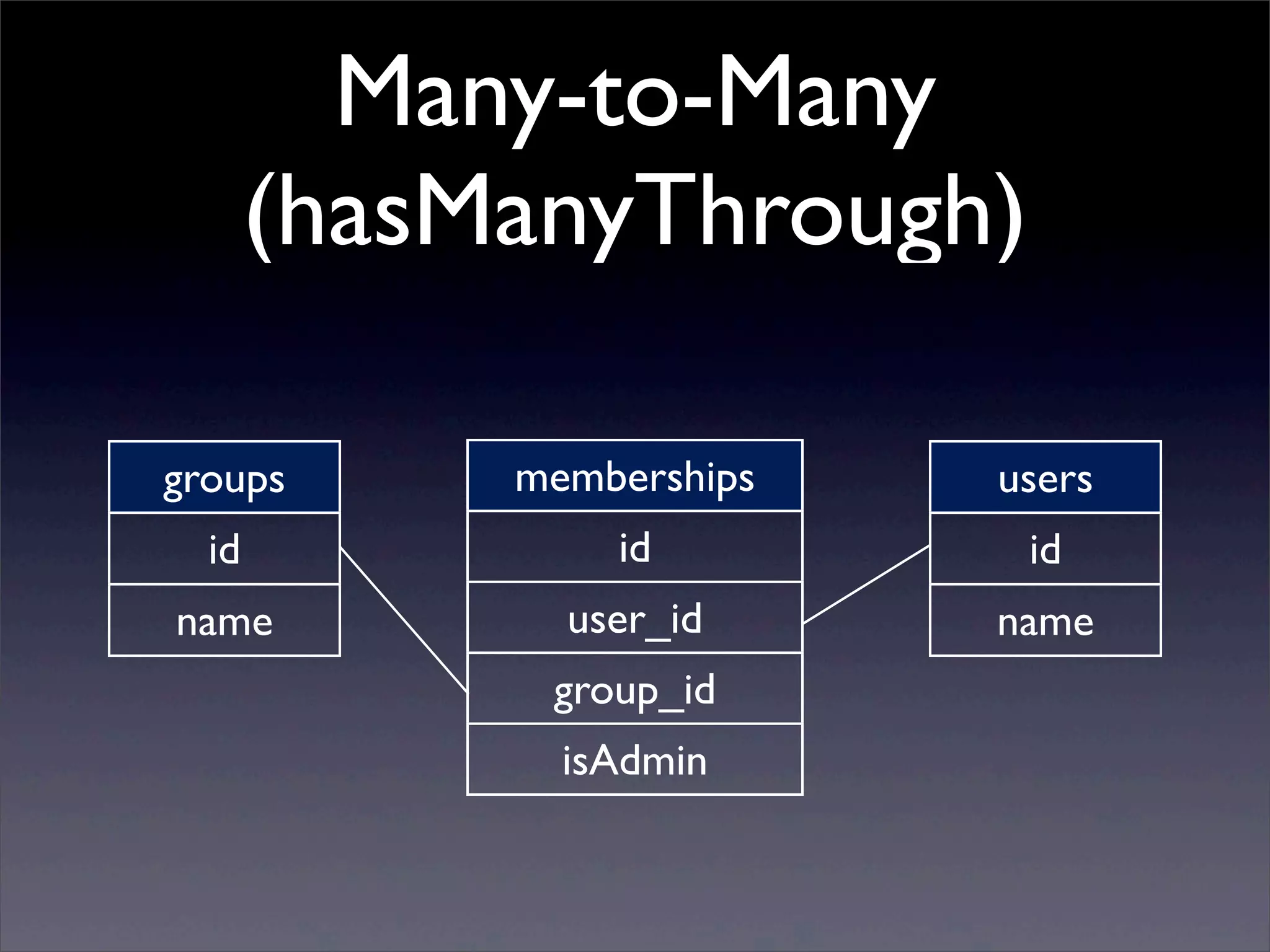
![Many-to-Many
(hasManyThrough)
case class Membership(
! userId:Long, projectid:Long, isAdmin:Boolean = false
) extends ActiveRecord {
! lazy val user = belongsTo[User]
! lazy val group = belongsTo[Group]
}
case class User(name:String) extends ActiveRecord {
! lazy val memberships = hasMany[Membership]
! lazy val groups = hasManyThrough[Group, Membership](memberships)
}
case class Group(name:String) extends ActiveRecord {
! lazy val memberships = hasmany[Membership]
! lazy val users = hasManyThrough[User, Membership](memberships)
}](https://image.slidesharecdn.com/scala-activerecord-130624144236-phpapp02/75/Scala-active-record-53-2048.jpg)
)
}
group.adminUsers << user
// user.isAdmin == true](https://image.slidesharecdn.com/scala-activerecord-130624144236-phpapp02/75/Scala-active-record-54-2048.jpg)

}](https://image.slidesharecdn.com/scala-activerecord-130624144236-phpapp02/75/Scala-active-record-55-2048.jpg)
 => client.id === order.clientId
).where(
! (client, order) => client.age.~ < 20 and order.price.~ > 1000
).select(
! (client, order) => (client.name, client.age, order.price)
).toList
generated SQL
Select clients.name, clients.age, order.price
From clients inner join orders on (clients.id = orders.client_id)
Where ((clients.age < 20) and (groups.price > 1000))](https://image.slidesharecdn.com/scala-activerecord-130624144236-phpapp02/75/Scala-active-record-56-2048.jpg)
